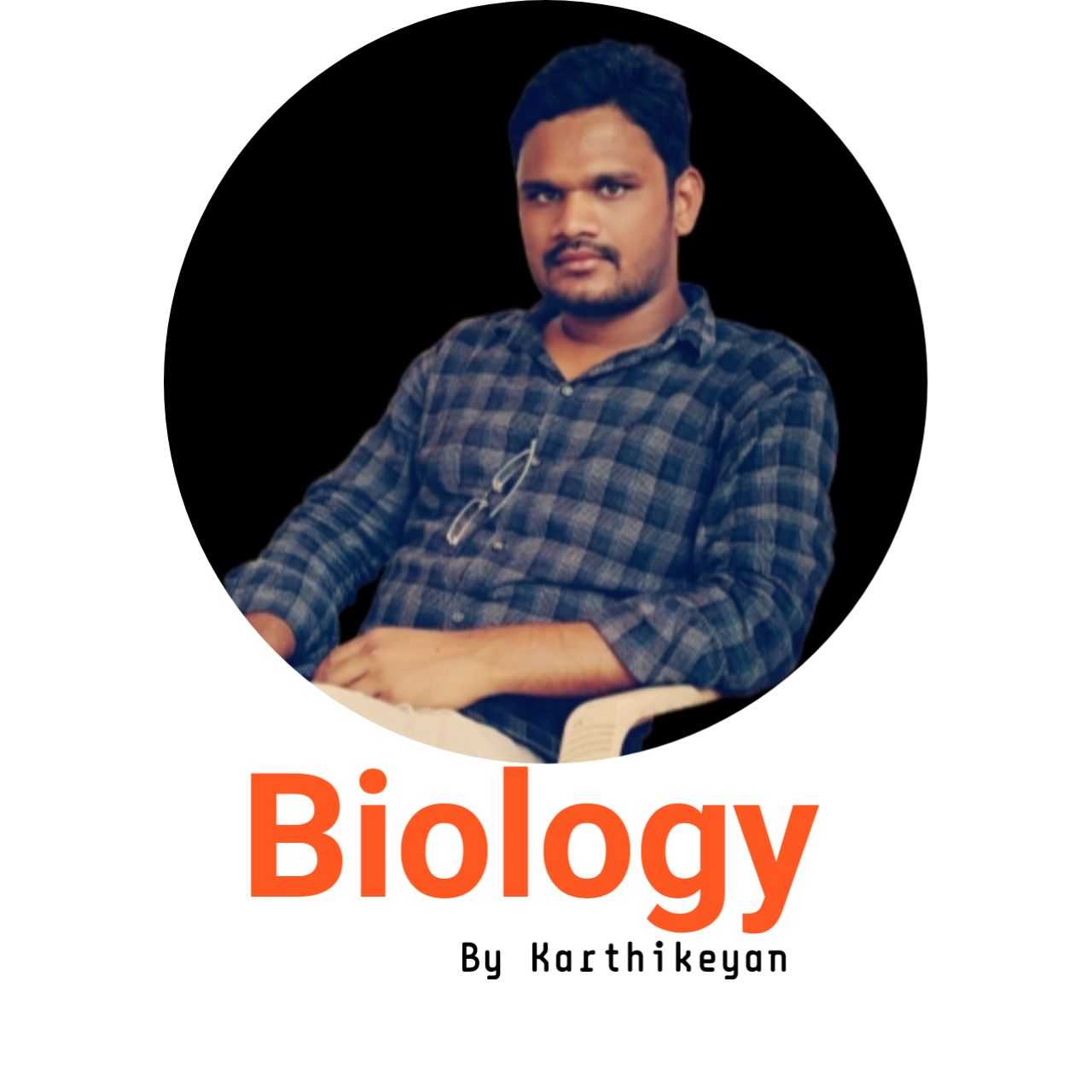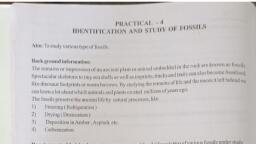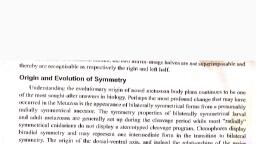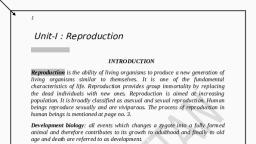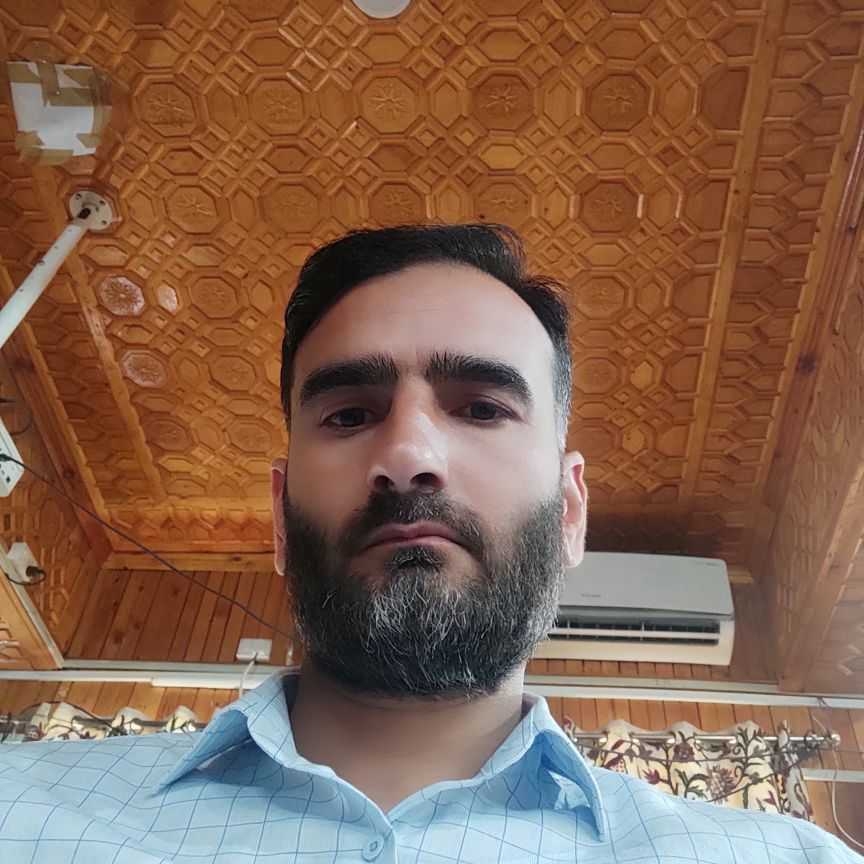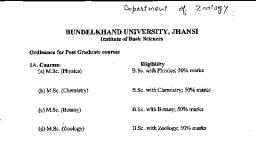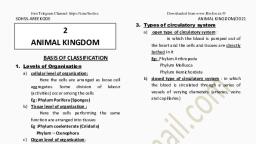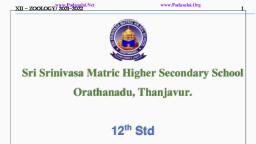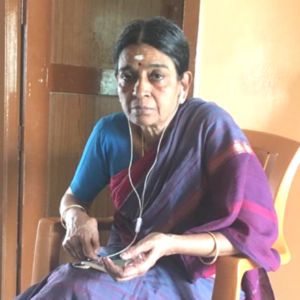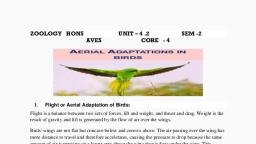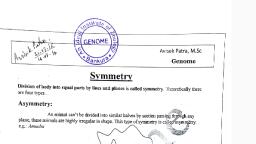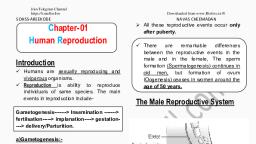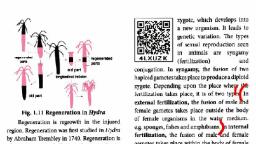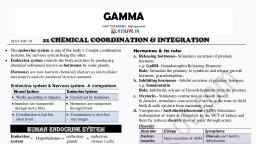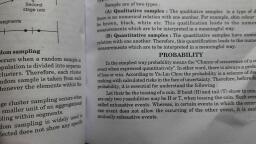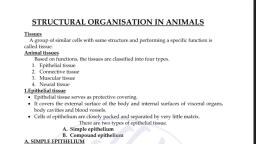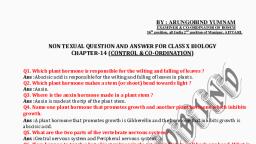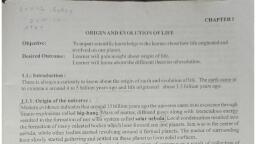Page 2 :
TELANGANA STATE BOARD OF, INTERMEDIATE EDUCATION, , ZOOLOGY, FIRST YEAR, (English Medium), , BASIC LEARNING MATERIAL, , ACADEMIC YEAR, 2021-2022
Page 4 :
PREFACE, , The ongoing Global Pandemic Covid-19 that has engulfed the entire world has changed every, sphere of our life. Education, of course is not an exception. In the absence of Physical Classroom, Teaching, Department of Intermediate Education Telangana has successfully engaged the students and, imparted education through TV lessons. In the back drop of the unprecedented situation due to the, pandemic TSBIE has reduced the burden of curriculum load by considering only 70% syllabus for class, room instruction as well as for the forthcoming Intermediate Examinations. It has also increased the, choice of questions in the examination pattern for the convenience of the students., To cope up with exam fear and stress and to prepare the students for annual exams in such a, short span of time , TSBIE has prepared “Basic Learning Material” that serves as a primer for the, students to face the examinations confidently. It must be noted here that, the Learning Material is not, comprehensive and can never substitute the Textbook. At most it gives guidance as to how the students, should include the essential steps in their answers and build upon them. I wish you to utilize the Basic, Learning Material after you have thoroughly gone through the Text Book so that it may enable you to, reinforce the concepts that you have learnt from the Textbook and Teachers. I appreciate ERTW, Team, Subject Experts, who have involved day in and out to come out with the, Basic Learning Material, in such a short span of time., I would appreciate the feedback from all the stake holders for enriching the learning material, and making it cent percent error free in all aspects., The material can also be accessed through our websitewww.tsbie.cgg.gov.in., , Commissioner & Secretary, Intermediate Education, Telangana.
Page 5 :
CONTENTS, UNIT - I, , Diversity of Living World, , 1, , UNIT - II, , Structural Orgaisation in Animals, , 5, , UNIT - III, , Animal Diverstity - I, , 13, , UNIT - IV, , Animal Diverstity - II, , 20, , UNIT - V, , --, , UNIT - VI, , Biology in Human Welfare, , UNIT - VII -UNIT - VIII Ecology & Environment, , -27, -43
Page 6 :
1, , Zoology - I, , Unit, , 1, , Diversity of Living World, VERY SHORT ANSWER TYPE QUESTIONS, 1., Ans:, 2., Ans:, , 3., Ans:, , 4., Ans:, 5., Ans:, , 6., Ans:, 7., Ans:, 8., Ans:, 9., Ans:, , What is biogenesis?, If the Life comes only from life is called biogenesis., Distinguish between embryology and ethology., Embryology: The branch of biology dealing with the formation and development of, embroys., Ethology: The study of the animal behaviour., What is trinominal nomenclature? Give an example?, The naming of an animal with a three worded name is called trinominal nomenclature., The first word refers to genus, second word refers to species and third word refers to, subspecies eg: Corvus splendenss plendens., What is meant by tautonymy?Give two examples?, The practice of naming the animals, in which the generic name and species name are the, same,is called tautonymy. Eg: Axis axis, (spotted deer) Naja naja (the indian cobra)., Differentiate between Protostomia and Deuterostomia?, The eumetazoans in which mouth develops from blastopore are called as protostomians., The Eumetazoans in which anus develops from or near blastopore are called as, Deuterostomians., What does ICZN stands for?, International Code of Zoological Nomenclature., Give the names of any four protostomian phyla., Platyhelminthes, Nematoda, Annelida, Arthropoda and Mollusca., What is the Ecological diversity?mentioin the different types of ecological diversities?, Diversity at a higher level of organization ,i.e at the ecosystem level is called Ecological, diversity. The different types are Alpha diversiy, Beta diversity, Gamma diversity., Define species richness., It is the number of species per unit area. The more the number of species in an area the, more is the species richness., , S, T, , E, I, B
Page 7 :
2, , Basic Learning Material, , 10. Mention any two products of medicinal importance obtained from nature?, Ans: Anti cancer drug—Vinblastin, To treat certain cardiac problems—-Digitalin, 11. Invasion of an alien species leads to extinction of native species. Justiy this with two, examples?, Ans: 1. Nile perch introduced into Lake Victoria, in east Africa led to the extinction of 200, species of cichlid fish in the lake., 2. Illegal introduction of exotic African catfish Clariasgariepinus, for aquaculture, purposes is posing a threat in the indigenous cat fishes., 12. List out any four sacred grooves in India?, Ans: Khasi and Jainta Hills—Meghalaya, Aravalli Hills—Rajasthan and Gujarat, Western Ghat region— Karnataka and Maharashtra, Sarguja, Bastar——Chhattisgarh, Chanda——Madhya Pradesh, 13. Write the full form of IUCN. In which book threatened species are enlisted?, Ans: International Union for the Conservation of Nature and Natural Resources., In Red Data Books threatened species are enlisted., , S, T, , E, I, B, , SHORT ANSWER TYPE QUESTIONS, , 1., Definespecies. Explain the various aspects of species?, Ans: Species is a group of similar organisms sharing a common gene pool and interbreeding, freely, producing fertile offspring., John ray in his book Historia Generalis Plantarum used the term species., Linnaeus considered species, in his bookSystema Naturae as the basic unit of classification., Buffon,in his book Natural History proposed the idea of evolution of species, which is, the foundation for the biological concept of evolution, which became more popular with, the publication of the book The Origin of Species by Charles Darwin., Species is considered a group of individuals which are:, 1. Reproductively isolated from the individuals of other species—a breeding unit., 2. Sharing the same ecological niche—an ecological unit., 3. Showing similarity in the karyotype – a genetic unit., 4. Having similar structure and functional characteristics—an evolutionary unit., 2., What is genetic diversity and what are the different types of genetic diversity?, Ans: The term biodiversity was popularized by the sociobiologist Edward Wilson to describe, the combined diversity at all levels of biological organization., The three levels of biodiversity are 1)Genetic diversity 2)Species diversity 3)Ecological, diversity.
Page 8 :
3, , Zoology - I, , 3., Ans:, , 4., Ans:, 1), , 2), 3), , 4), 5., Ans:, , Genetic diversity: It is the diversity of genes within a species. A single species may show, high diversity at the genetic level over its distributional range. E.g: Rauwolfia vomitoria,, a medicinal plant growing in the Himalayan ranges shows great genetic variation, which, might be in terms of potency and concentration of the active chemical that the plant produces., India has more than 50,000 different strains of rice, and 1000 varieties of mangoes. Genetic, diversity increases with environmental variability and is advantageous for its survival., Species Diversity: It is the diversity at the species level. E.g. amphibian diversity in the, western ghats is greater than that of the eastern ghats., Ecological Diversity: Diversity at a higher level of organization that is at the ecosystem, level is called ecological diversity., What are the reasons for greater biodiversity in the tropics?, There are three reasons for greater biodiversity in the tropics., 1) Tropical latitudes have remained relatively undisturbed for millions of years and thus, had a long evolutionary time. As long duration was available in this region for, speciation, it led to the species diversification., 2) Tropical climates are relatively more constant and predictable than that of the temperate, regions. Constant environment promotes niche specialization, and this leads to greater, species diversity., 3) Solar energy, resources like water etc, are available in abundance in this region. This, contributed to higher productivity in terms of food production, leading to greater, diversity., What is the evil quarlet?, The four major causes for accelerated rates of species extinction in the world are called, evil quarlet., Habitat loss and Fragmentation: i) Deforestation leads to species extinction in forests, ii)Conversion of forest land to agricultural landeg Amazon rain forest, iii)pollution enhances, degradation of habitats iv)fragmentation of habitat leads to population decline eg mammals, and birds., Over-Exploitation:When need turns to greed it leads to over exploitation. E.g. Stellers, sea cow, passenger pigeon., Invasion of Alien Species: When alien species are introduced into a habitat they turn, invasive and establish themselves at the cost of the indigenous species. Eg. Nile perch, introduction into lake victoria,led to extinction of 200 species of cichlid fish., Co-Extinctions:In an obligate association between a plant and an animal, if a plant becomes, extinct, the animal also becomes extinct as seen in a parasite and host association., Explain in brief biodiversity hotspots?, The concept of biodiversity hot spot was proposed by Norman Myers, there are about 34, biodiversity hot spots in the world. As these regions are threatened by destruction, habitat, , S, T, , E, I, B
Page 9 :
4, , Basic Learning Material, , loss is accelerated e.g: 1)Westernghats and Srilanka 2)Indo Burma 3)Himalayas in india., Ecologically unique and biodiversity rich regions are legally protected as in 1)Biosphere, Reserves 2)National parks 3)Sanctuaries., Biosphere Reserves: An area which is set aside, minimally disturbed for the conservation, of the resources of the biosphere is Biosphere Reserve.Eg:Seshachalam hills., National Parks: A national park is a natural habitat strictly reserved for protection of, natural life. Eg:Jim Corbett national park,MahavirHarinavanasthali national park etc, Sanctuaries: Specific endangered faunal species are well protected in wildlife sanctuaries, which permits eco-tourism. Eg:Koringa sanctuary, Eturnagaram sanctuary., 6., Explain Rivet popper hypothesis?, Ans: Paul Ehrlich’s experiments ‘the RIVET POPPER hypothesis, taking an aero plane as an, ecosystem, explains how removal of one by one ‘rivets’ (species of an ecosystem) of various, parts can slowly damage the plane(ecosystem)-shows how important a ‘species’ is in the, overall functioning of an ecosystem. Removing a rivet from a seat or some other relatively, minor important parts may not damage the plane, but removal of a rivet from a part, supporting the wing can result in a crash. Likewise, removal of a ‘critical species’ may, affect the entire community and thus the entire ecosystem., 7., Write short notes on in-situ conservation?, Ans: In-situ conservation (On-site conservation), In-situ conservation is the process of protecting an animal species in its natural habitat., The benefit is that it maintains recovering populations in the surrounding where they have, developed their distinctive properties. Conservationists identified certain regions by name, ‘Biodiversity hot spots’ for maximum protection as they are characterized by very high, levels of species richness and high degree of endemism., Methods of In-situ conservation are:, 1)Biosphere Reserves 2)National parks 3)Sanctuaries 4)sacred groves, Biosphere Reserves: An area which is set aside, minimally disturbed for the conservation, of the resources of the biosphere is Biosphere Reserve.Eg:Seshachalam hills., National Parks: A national park is a natural habitat strictly reserved for protection of, natural life. Eg:Jim Corbett national park,MahavirHarinavanasthali national park etc, Sanctuaries: Specific endangered faunal species are well protected in wildlife sanctuaries, which permits eco-tourism. Eg:Koringa sanctuary, Eturnagaram sanctuary., Sacred Groves: i) A small group of trees than a forest is called grove., ii) A groove of trees of special religious importance to a particular culture is called sacred, grove., iii) In these regions all the trees of wild life are respected and given total protection., , S, T, , E, I, B
Page 10 :
5, , Zoology - I, , Unit, , 2, , Structural Orgaisation in Animals, VERY SHORT ANSWER TYPE QUESTIONS, 1., , What is Cephalization? How is it useful to its possessors?, , E, I, B, , Ans: Cephalization: Concentration of nerve (Brain) and sensory cells at the anterior end of the, body is called as Cephalization. • Uses - searching of food, locating mates and in escaping, from predators., 2., , Mention the animals that exhibited a ‘tube-within-a-tube’ organization for the first, time? Name their body cavity?, , S, T, , Ans: Phylum Nematoda, , • Body cavity is pseudocoelom.., 3., , Why is the true coelom considered a secondary body cavity?, , Ans: During embryonic development the blastocoel is replaced by true coelom derived from the, mesoderm. So,the true coelom is also called secondary body cavity., 4., , What are retroperitoneal organs?, , Ans. The organs which are lined by peritoneom only on their ventral side are called retroperitoneal, organs., Ex: Kidney, 5., , What is enterocoelom? Name the enterocoelomate phyla in the animal kingdom?, , Ans: Animals in which the body cavity is formed from the mesodermal pouches of archenteron, are called ‘enterocoelomates’. Echinoderms, hemichordates and chordates are the, enterocoelomates., 6., , Distinguish between exocrine and endocrine glands with examples., , Ans: Exocrine glands are provided with ducts., Ex: mucus, saliva, earwax, oil, milk,, Endocrine glands are ductless glands and their products are called hormones., Ex: Pituitary Gland
Page 11 :
6, , Basic Learning Material, , 7., Distinguish between holocrine and apocrine glands?, Ans: Apocrine glands: Apical part of the gland cell is pinched off along with the secretory, product. Ex: mammary glands., • Holocrine glands, The entire cell disintegrates to discharge the contents., Ex: Sebaceous glands, 8., Mention any two substances secreted by mast cells and their functions?, Ans: Heparin——Anticoagulant,Histamine,Bradykinin——Vasodilators, Serotonin—Vasoconstrictor., 9., Distinguish between a tendon and a ligament?, Ans: Tendons attach the skeletal muscle to bone., Ligaments attach bones to other bones., 10. Distinguish between brown fat and white fat?, Ans: White Fat: Adipocyte is Monolocular, Metabolically less active, Brown Fat: Adipocyte is Multilocular, Metabolically more active., 11. What is the strongest cartilage? In which regions of the human body, do you find it?, Ans: The fibrous cartilage is the strongest of all types of cartilages., • It occurs in the intervertebral discs and pubic symphysis of the pelvis., 12. Distinguish between Osteoblasts and Osteoclasts?, Ans: Osteoblasts are immature bone cells and secrete the organic components of matrix of, bone., • Osteoclasts are phagocytic cells involved in resorption of bone., 13. Define Osteon?, Ans: In compact bone structure a haversian canal and the surrounding lamellae and lacunae are, collectively called a Haversian system or Osteon., 14. What are Volkmann’s canals ?What is their role?, Ans: Transverse or Oblique canals of HaversionSystem,for communication between Haversion, canals., 15. What is a Sesamoid Bone? Give an example., Ans: Sesamoid bones are formed by ossification in tendons., • Ex: Patella (Knee cap) of a mammal., 16. What is Lymph?How does it differ from plasma?, Ans: It is a colourless interstitial fluid,, Absence of RBC,Platelets and Large Plasma Proteins., 17. What is the haematocrit value?, Ans: The percentage of total volume occupied by RBCs in blood is called haematocrit value., 18. What are intercalated discs? What is their significance?, Ans: The dark lines across cardiac muscle are called intercalated discs (IDS)., • These are communication junctions., • They are useful for conduction of action potentials among cardiac muscles., , S, T, , E, I, B
Page 12 :
7, , Zoology - I, , 19. Cardiac muscle is highly resistant to fatigue. Justify?, Ans: Cardiac muscle has numerous sarcosomes, many molecules of myoglobin (oxygen storing, pigment) and rich supply of blood which facilitate continuous aerobic respiration., • Thus cardiac muscle is highly resistant to fatigue., 20. Name the glial cells that form myelin sheath around the axons of central nervous, system and peripheral nervous system respectively ?, Ans: Central Nervous System—Oligodendrocytes, PheripheralNervous System —Schwann cells., 21. Distinguish between white matter and greymatter of CNS?, Ans: White matter: It has Myelinated Nerve fibres., Grey matter: It has Non-Myelinated Nerve fibres., 22. What are microglia and what is their origin and add a note on their function?, Ans: Microglial cells are the Neuroglia (supporting cells) cells of CNS., They are phagocytic cells and mesodermal origin.., 23. What are pseudo unipolar neurons? Where do you find them?, Ans: Pseudounipolar neurons are sensory neurons having a single process arising from the cell, body., •, It divides into two branches, one of which acts as a dendrite and other as an axon., They are present in dorsal root ganglion of spinal nerve., , E, I, B, , S, T, , SHORT ANSWER TYPE QUESTIONS (4 MARKS ), 1., Describe the formation of Schizocoelom and enterocoelom?, Ans: Schizocoelom:The 4d blastomere or mesentoblast cell of the early embryo divides to form, mesodermal blocks between the ectoderm and the endoderm and replaces the blastocoel.., The split that appears in mesodermal block leads to the formation of schizocoelom. Eg:, Annelids, Arthropods and Molluscs., Enterocoelom: Mesodermal pouches that evaginate from the wall of the archenteron into, the blastocoel are fused with one another to form the enterocoelom. Ex: Echinodermata, chordata., , 2., Describe briefly about the three types of intercellular junctions of epithelial tissues?, Ans: Tight junctions: The plasma membranes of adjacent cells are tightly pressed against each, other and are bound together by specific proteins.
Page 13 :
8, , Basic Learning Material, Eg: Prevent leakage of water into the surrounding cells in our sweat glands., Desmosomes: Which act as rivets binding the cells together into strong sheets. Intermediate, filaments made of the protein keratin anchor the desmosomes in the cytoplasm., Eg: Epithelial and muscle cells., Gap junctions: They provide continuous cytoplasmic channels between adjacent cells., Eg; cardiac muscle., , E, I, B, , 3., Give an account of glandular epithelium?, Ans: Some of the columnar or cuboidal cells that get specialized for the production of certain, secretions, form glandular epithelium., Unicellular glands: Isolated glandular cells such as goblet cells of gut., Multicellular glands: Clusters of cells such as salivary glands., On the basis of mode of pouring of secretions, Exocrine: sent their secretions through duct to the target organs., Endocrine: sent their secretions through blood to the target organs., 4., Give a brief account of the cells of Areolar Tissue?, Ans. It is one of the most widely distributed connective tissue in the body., Cells of the areolar tissue:, Fibroblasts are the most common cells which secrete fibers. The inactive cells are called, fibrocytes., Mast cells secrete heparin (an anticoagulant), histamine, bradykinin (vasodilators), and, serotonin (vasoconstrictor)., , S, T
Page 14 :
9, , Zoology - I, , Macrophages are amoeboid cells, phagocytic in function and act as internal scavengers., They are derived from the monocytes of blood., Plasma cells are derived from the B – lymphocytes and produce antibodies., Adipocytes are specialized cells for the storage of fats., 5., Describe the three types of cartilage?, Ans: Cartilage is a solid, but semi – rigid (flexible) connective tissue., a) Hyaline Cartilage:, It is bluish – white, translucent cartilage., Matrix is homogeneous and shows delicate collagen fibres., It is the weakest and the most common type of all the cartilages., It forms the embryonic endoskeleton of bony vertebrates, endoskeleton of cyclostomes., It forms the nasal septal cartilage, Cartilaginous rings of trachea, bronchi and cartilages of, larynx., , E, I, B, , S, T, , b) Elastic Cartilage:, It is yellowish due to elastic fibres., Matrix has abundance of yellow elastic fibres in addition to collagen fibres., It provides strength and elasticity. Perichondrium is present., It is found in the pinnae of the external ears, Eustachian tubes and epiglottis., , (b) Elastic Cartilage:
Page 15 :
10, , Basic Learning Material, c) Fibrous Cartilage:, Matrix has bundles of collagen fibres. Perichondrium is absent., It is the strongest of all types of cartilages., It occurs in the intervertebral discs and pubic symphysis of the Pelvis., , E, I, B, , 6., Explain Haversian system?, Ans: The compact bone consists of several, structural units called Osteons or, Haversian systems arranged between, the outer and inner circumferential, lamellae., A haversian canal and the surrounding, lamellae and lacunae are collectively, called a haversian system or osteon., The spaces between the haversian, systems are filled with interstitial, lamellae., Haversian system consists of a Haversian canal that runs parallel to the marrow, cavity,anartery,a vein and a lymphatic vessel., Haversian canal is surrounded by concentric lamellae, small fluid filled spaces called lacunae, provided with minute canaliculi lie in between the lamellae., Canaliculi connect the lacunae with one another and with haversian canal., Each lacunae encloses one osteocyte, the cytoplasmic processes of osteocytes extend through, canaliculi and get inter connected into a network of cells., Haversian canals communicate with one another, with the periosteum and also with the, marrow cavity by transverse or oblique canals called volkmaknns canals., Nutrients and gases diffuse from the vascular supply of haversian canals., 7., Describe the structure of a skeletal muscle?, Ans: Skeletal (Striped and Voluntary) Muscle:, , S, T
Page 16 :
11, , Zoology - I, •, , Skeletal muscle is usually attached to skeletal structures by, ‘tendons’., A skeletal muscle fiber is a long, cylindrical and unbranched, cell.It is a multinucleate cell with many oval nuclei, Muscle fibre is surrounded by sarcolemma., Its cytoplasm is called sarcoplasm., Sarcoplasm has many myofibrils whichshow alternate dark and, light bands., So it is called striped or striated muscle., It is a voluntary muscle. It contracts quickly and undergoes fatigue, quickly., 8., Describe the structure of a cardiac muscle?, Ans: Cardiac muscle is also called as striated and involuntary muscle., Cardiac muscles are found in the‘myocardium’ of the heart of vertebrates., The cardiac muscle cells are short, cylindrical, mononucleate or binucleate cells., Whose ends are branch and form junctioinns with other cardiac muscle cells., Each cell is joined to adjacent cell by electrical synapses or gap junctions,which permit, electrical impulses to be conducted along the long axis of the cardiac muscle fibre. The, dark lines across cardiac muscle are called intercalated discs(communication junctions)., The intercalated discs contain three different types of cell junctions and the gap junctions, which are responsible for rapid conductioin of action potentials., , E, I, B, , S, T, , 9., Given an account of the supporting cells of nervous tissue?, Ans: The supporting and non-conducting cells that provide a microenvironment suitable for, neuronal activity.They continue to divide throughout the life., CNS has Oligodendrocytes—form myelin sheath,, Astrocytes—bind neurons and capillaries,, Ependymal cells—ciliated cells line the cavities,, Microglial cells—— phagocytic cells., PNS has Satellite cells—surround the cellbodies in ganglia and Schwann cell- form, neurilemma around axons.
Page 17 :
12, , Basic Learning Material, , 10., , Describe the structure of a multipolar, neuron?, Ans: Neurons are the functional units of nervous, tissue. A neuron usually consists of a cell body, with one to many dendrites and a single axon., Cell body: It is also called perikaryon,cyton, or soma. It contains abundant granular, cytoplasm and a large spherical nucleus. The, cytoplasm has nisslbodies,neurofibrils and, lipofuscin granules., Dendrites: Several short branched processes, which arise from the cyton are called, dendrites. They also contain nissl bodies and, nerve fibrils. They conduct nerve impulses, towards the cell body., Axon: An axo is a single,long ,cylindrical, process that originates from a region of the, cyton called axon hillock. Plasmalemma of, an axon is called axolemma, and the cytoplasm is called axoplasm. Which contains, neurofibrils, Nissl bodies are absent. An axon may give rise to collateral branches. Distally, it branches into many fine filaments called telodendria, which end in bulb like structures, called synaptic knobs or terminal boutons. Synaptic knobs possess synaptic vesicles, containing chemicals called neurotransmitters., 11. Write short notes on (A)Platelets and (B)Synapse?, Ans: Platelets: These are colourless non-nucleated, round or oval biconvex discs., They are formed from giant megakaryocytes produced in the red bone marrow by, fragmentation. Number of platelets per cubic mm of blood is about 2,50,000-4,50,000., The average life-span is about 5 to 9 days. They secrete thromoboplastin,which plays a, role in blood clotting., Synapse: The minute structural gap or functional bridge between the telodendrites of one, neuron and the dendrites of another neuron is called synapse., , S, T, , E, I, B
Page 18 :
13, , Zoology - I, , Unit, , 3, , ANIMAL DIVERSITY - I, VERY SHORT ANSWER TYPE QUESTIONS, 1., What are the functions of canal system of sponges?, Ans: Transport of water, gathering food (filter feeders), exchange of gases and removal of wastes., 2., What are the two chief morphological ‘body forms’ of cnidarians? What are their, chief functions?, Ans: i) The body forms of Cnidarians are polyp and medusa., ii) Polyp produces medusa by asexual reproduction. Polyp for nutrition., iii) Medusae produces polyp by sexual reproduction. Medusae for reproduction., 3., What is Metagenesis? Animals belonging to which phylum exhibit Metagenesis?, Ans: Exhibit of alternation of generations by organisms is called metagenesis. Cnidarian phylum., 4., What are the excretory cells of flatworms called? What is the other importantfunction, of these specialized cells?, Ans: The excretory cells of flatworms are flame cells. Other important function of these cells is, osmoregulation., 5., Distinguish between Amphids and Phasmids?, Ans: Amphids and phasmids are present in nematodes as sense organs., Amphids: Cuticular depressions around oral region, chemoreceptor in fuction., Phasmids: Posterior glandulo-sensory structures., 6., what is the essential difference between a flatworm and a round worm with reference, to the perivisceral areas of their bodies?, Ans: Flatworms—Acoelomate animals, Roundworms—Pseudocoelomate animals., 7., What do you call the locomotor structures of Nereis? Why Nereis is called a, polychaete?, Ans: Locomotor structures of Nereis are parapodia. The parapodia bear many setae help in, locomotion hence the name polychaete, 8., What is botryoidal tissue?, Ans: Coelom of leeches is filed with a characteristic tissue called botryoidal tissue, it is resembling, , S, T, , E, I, B
Page 19 :
14, , 9., , Ans:, , 10., Ans:, 11., Ans:, 12., Ans:, 13., Ans:, 14., Ans:, 15., Ans:, 16., Ans:, 17., Ans:, 18., Ans:, , Basic Learning Material, a bunch of grapes.They range from excretion to storage of iron, calcium, revascularization, in area of injury, What is the difference between the epidermis of a nematode and that of an annelid?, How does a nematode differ from an annelid with reference to the musculature of the, body wall?, In nematodes the body is covered by a transparent,tough, and protective collagenous cuticle,, in some epidermis is syncytial.Only longitudinal muscles are present., The annelids posessdermo-muscular body wall, containing cuticle, epidermis, dermis,, longitudinal and circular muscles., What do you call the first and second pairs of cephalic appendages of a scorpion?, First pair - Chelicerae and second pair -Pedipalpi, What is the uniqueness about the first two pairs of cephalic appendages of a crustacean, compared to those of the other extant arthropods?, The presence of two pairs of antennae (antennules and antennae) is the unique feature of, crustacean., What is the sub-phylum to which ticks and mites belong? How do you distinguish, them from the insects with reference to their walking legs?, Sub-phylum chelicerata, Ticks and mites has four pairs of walking legs,Insects has three, pairs of walking legs., What are the respiratory structures of Limulus and Palamnaeus respectively?, The respiratory structures Limulus - book gills,Palamnaeus - book lungs, What are antennae? What is the arthropod group without antennae?, It is an cephalic appendage,which are sensory in function, they are absent in chelicerata, sub-phylum., Which arthropod, you have studied, is called a living fossil? Name its, respiratoryorgans?, i) Limulus(king crab) is considered as a living fossil among arthropods., ii) Respiratory organs are book – gills belong to mesosoma of the body., How do you identify a chiton from its external appearance? How many pairs of gills, help in the respiration of chiton?, Shell is dorsal and consists of eight transverse plates (valves)., 6 to 88 pairs of gills help in respiration., What is the function of radula? Give the name of the group of molluscs which do not, possess a radula?, The buccal cavity contains a file – like rasping organ called radula for feeding in molluscans,, except in bivalves or lamellibranchiates or pelecypodans., What is the other name for the gill of a mollusc? What is the function of Osphradium?, The other name for the gill of a mollusc is Ctenidia., The main function of Osphradium is to test the purity of water., , S, T, , E, I, B
Page 20 :
15, , Zoology - I, , 19. What is Aristotle’s lantern? Give one example of an animal possessing it?, Ans: In the mouth of sea Urchin a complex five jawed masticatory apparatus called Aristotle’s, lantern., Ex: Echinus, 20. What is the essential difference between the juveniles and adults of echinoderms,, symmetry wise?, Ans: The adult echinoderms are radially symmetrical (pentamerous radial symmetry)., But juveniles (Larvae) are bilaterally symmetrical., 21. What are blood glands in Pheretima?, Ans: Blood glands are present in 4th, 5th and 6th segments in Pheretima., Blood glands produce blood cells and haemoglobin which is dissolved in plasma., 22. What are spermathecae on the body of Pheretima?, Ans: Four pairs of spermathecae are present in the 6th, 7th, 8th and 9th segments in Pheretima., Spermathecae receive and store spermatozoa in the form of bundles known spermatophores, during copulation., , E, I, B, , SHORT ANSWER TYPE QUESTIONS (4 MARKS), 1., Write short notes on the salient features of the anthozoans?, Ans: 1) Anthozoans are commonly referred to as sea anemones, 2) Anthozoa includes sea anemones, corals, sea pens, 3) All are marine forms. These are solitary or colonial, 4) They are sedentary and only polyploidy inform, 5) Coelenteron is divided into several compartments by vertical septa called mesenteries, 6) Mesoglea contains connective tissue, 7) Cnidocytes occur both in the ectoderm and endoderm and is cellular as contains, amoebocytes, 8) Germ cells are derived from endoderm, Ex: Adamsia (sea anemone), Gorgonia (sea fan), Pennatula (sea pen), 2., What are the salient features exhibited by Polychaetes?, Ans: 1) These are commonly known as bristle worms ,includes marine annelids., 2) Some are free movingand others burrowing or tubicolous, 3) Head is distinct with sensory structures like eyes,tentacles and palps., 4) Clitellum is absent, 5) Parapodia bear many setae which help in locomotion and respiration., 6) Unisexual,Gonoducts are absent, 7) Gametes are shed into coelom and passed out through the nephridiopores., 8) Fertilization is external, 9) Development includes a trochophore larva., Ex: Nereis, , S, T
Page 21 :
16, , Basic Learning Material, , 3., What are the chief characters of the crustaceans?, Ans: 1. These are aquatic organisms., 2. Head and thorax fuse forming the cephalothorax., 3. Exoskeleton is hardened by calcium carbonate., 4. Cephalic region bears two pairs of antennae,one pair of mandibles and two pairs of, maxillae., 5. Thoracic and abdominal appendages are biramous., 6. Respiratory organs are gills,exceretory organs are green glands or antennary glands, 7. Sense organs includeantennae,compoundeyes,statocysts ,etc, 8. Development is indirect, includes different larval forms., Ex: Palaemon (prawn), Cancer (crab), 4., Mention the general characters of Arachnida?, Ans: 1. These are terrestrial organisms., 2. Body is divided into prosoma and opisthosoma( mesosoma and metasoma ), 3. Prosoma bears a pair of chelicerae, apair of pedipalpi and four pairs of walking legs., 4. Mesosomal appendages are modified into book-lungs., 5. Four pairs of posterior abdominal appendages are modified into spinnerets in spiders., 6. Respiratory organs are book-lungs, tracheae or both., 7. Respiratory pigment is ‘copper’ containing haemocyanin., 8. Excretory organs are Malpighian tubules and coxal glands., 9. Development is direct., 10. Scorpions are viviparous, 5., Compare briefly a centipede and a millipede?, Ans: Centipedes, 1. Centipedes are commonly called hundred-leggers., 2. They are terrestrial, air-breathing,carnivorous animals., 3. Body consists of head and trunk., 4. Each segment of the trunk bears a pair of clawed appendages., 5. First pair of trunk appendages bears poison claws., 6. Respiratory structures are tracheae,excretory organs are Malpighiantubules.Ex:, Scolopendra, Millipede, 1. Millipede are commonly called thousand-leggers., 2. They are terrestrial, air-breathing,feedig on decaying plant material., 3. Body consists of head and trunk., 4. Head bears paired antennae,mandibles and maxillae., 5. Each trunk segment bears two pairs of legs., 6. Respiratory organs are tracheae, excretory organs are Malpighiantubules.Ex:, Spirostreptus, , S, T, , E, I, B
Page 22 :
17, , Zoology - I, , 6., What are the salient features of the echinoids?, Ans: 1) It includes sea urchins, heart urchins, sand dollars, etc. The body is ovoid or discoidal, and covered by movable spines ., 2) Arms are absent,tube feet bear suckers ., 3) Calcareousossicles of the body unite to form a rigid test or corona or case, 4) Pedicellariaeare “three jawed”, 5) Anus and madreporite are aboral in position, 6) Ambulacral grooves are closed, 7) A complex five jawed masticatory apparatus called Aristotle’s lantern is present (abset, in the heart urchins)., 8) development includes echinnopluteus larva., Eg: echinus (sea urchin), echiocardium(heart urchin), 7., Mention the salient features of Holothuroidea?, Ans: Holothuroidea:, 1. This class includes sea cucumbers., 2. Body elongated in the oral – aboral axis., 3. Skin is soft and leathery (Coriaceous)., 4. Dermis contains loose spicules, 5. Arms, spines and pedicellariae are absent., 6. Mouth is surrounded by retractile tentacles, ( modified tube feet useful for feeding)., 7. Ambulacral grooves are closed, tub feet bear suckers., 8. Madreporite is internal., 9. Respiratory organs are a pair of cloacal respiratory trees., 10. Development indirect and includesauricularia larvae., Ex: Holothuria,synapta,, 8., How many types of nephridia occur in Pheretima? How do you distinguish them?, Ans: InPheretima, three types of nephridia are present as excretory organs., They are septal, integumentary and pharyngeal nephridia., These nephridia can be distinguished based on the following features., 1. Septalnephridia—nephrostomePresent(open),nephridioporeAbsent and enteronephric, 2. Pharyngealnephridia—-nephrostomeAbsent (closed),nephridioporeAbsent and, enteronephric., 3. Integumentarynephridia—nephrostomeAbsent(closed),nephridiopore Present, andexonephric., 9., Give an account of hearts in the circulatory system of Pheretima?, Ans: 1) In Pheretima, two types of hearts are present in circulatory system., 2) They are lateral hearts and lateral oesophageal hearts., 3) Two pairs of lateral hearts present in 7th and 9th segments.carry blood from dorsal, blood vessel to ventral blood vessel., , S, T, , E, I, B
Page 23 :
18, , Basic Learning Material, 4), , Two pairs of lateral hearts also called as lateral oesophageal hearts present in 12th, and 13th segments. They carry blood from dorsal blood vessel and supraoesophageal, blood vessel to ventral blood vessel., , LONG ANSWER TYPE QUESTIONS ( 8 MARKS ), 1., , Draw a labelled diagram of the reproductive organs of Pheretima., , E, I, B, , S, T, 2., , Describe the digestive system and process of digestion in Pheretima., • Earthworm is a terrestrial invertebrate., DIGESTIVE SYSTEM, The alimentary canal is a straight tube and runs from the first to the last segment of the, body., Alimentary canal consists of the following parts, Mouth – 1st segment, Buccal cavity – 2 to 3rd segment
Page 24 :
19, , Zoology - I, , Pharynx – 4th segment, Esophagus – 5 to 7 segments, Gizzard – 8th segment, Stomach – 9 to 14th segments, Intestine – 15th to last segment, Rectum – last 23 to 28 segments, Anus – last segment, The alimentary canal is a straight, tube and runs from the first to the, last segment of the body. The, mouth opens into the buccal cavity, (1-3) which leads into the, muscular pharynx(4th segment).A, small narrow tube oesophagus(57 segments),continues into a, muscular gizzard(8th segment). It, helps in grinding the small, particles of food the decaying, leaves (grinding mill)., The stomach extends from the, segments 9 to 14. The food of, earthworm decaying leaves and, other organic matter mixed with, the soil. Calciferous glands, present in the stomach neutralize, the humic acid present in the, humus of the soil., The intestine starts from the 15th segment and continues till the last segment, a pair of short, and conical intestinal caecae project from the intestine in the 26th segment. An internal, median fold of the dorsal wall of the intestine called typhlosole, helping in increasing the, area of absorption, is poorly developed in pheretima( between 26th and the rectum).The, alimentary canal opens to the exterior by a small rounded aperture called anus., Process of digestion, The ingested soil rich in organic matter passes through the digestive tract where digestive, enzymes breakdown complex food into smaller absorbable units. These simpler molecules, are absorbed through intestinal membranes and are utilized for various metabolic activities., , S, T, , E, I, B
Page 25 :
20, , Basic Learning Material, , Unit, , 4, , ANIMAL DIVERSITY - II, VERY SHORT ANSWER TYPE QUESTIONS, 1., , List out the characters shared by chordates and echinoderms., , Ans: Common characters of Chordates and Echinoderms:, , 2., , Fate of blastopore (Deuterostome condition), , 2., , Radial and indeterminate cleavage., , 3., , Enterocoelom., , Write four salient features of cyclostomes., , Ans: 1., , 3., , Body is long, slender, scaleless and eel like., , 3., , Mouth is round and suctorial., , 4., , Tongue bears horny teeth., , 5., , Heart is two chambered, , 6., , Endoskeleton is cartilaginous., , What is the importance of endostyle in lancelets and ascidians?, , 2., , Endostyle is mucous secreting longitudinal groove present in the ventral part of, pharynx., It helps in food collection. It is fore runner of the thyroid gland of vertebrates., , Name the type of caudal fin and scales that are present in a shark and Catla,, respectively., , Ans: 1., 2., 5., , S, T, , Cyclostomes are jawless, aquatic forms., , 2., , Ans: 1., , 4., , E, I, B, , 1., , In shark, caudal fin is heterocercal and scales are placoid, In catla fish, caudal fin is homocercal and scales are cycloid or ctenoid, , What is the importance of air bladder in fishes?, , Ans: 1., , In bony fishes air bladder acts a hydrostatic organ. So that fishes float easily at desired, levels., , 2., , It helps in vertical movement of fish., , 3., , In some fishes, it helps in respiration.
Page 26 :
21, , Zoology - I, , 6., How do you justify the statement- “heart in fishes is a branchial heart”., Ans: 1. Heart in fishes is two chambered, 2. It pumps blood directly to gills so it is called branchial heart., 7., What are claspers? Which group of fishes possesses them?, Ans: 1. Claspers are copulatory organs formed near pelvic fins of male shark., 2. They are found in cartilaginous fishes. Ex: Sharks, 8., How does the heart of an amphibian differ from that of a reptile?, Ans: 1. In amphibians, heart has three chambers(two auricles and one ventricle) with sinus, venosus and conus arteriosus., 2. In reptiles, heart has four incomplete chambers (2 auricles and partly divided ventricles), with sinus venosus and without conus arteriosus., 3. But in crocodiles, heart is completely divided into four chambers,, 9., How do you distinguish in a male frog from a female frog?, Ans: Male frogs have secondary sexual characters. They are absent in female frog, 1. Male frogs have Vocal sacs in the angles of lower jaw to amplify sound., 2. Male frogs have Copulatory pad on the first digit of each fore limb., 10. What are corporabigemina? Mention their chief function., Ans: Mid brain of frog is represented by a pair of optic lobes called corpora bigemina. They are, associated with sence of sight., 11. Distinguish between milt and spawn., Ans: 1. Spawn is mass of eggs released by female frog (lower aquatic vertebrates)., 2. Milt is mass of sperms released by male frog (lower aquatic vertebrates)., 12. Name two poisonous and non poisonous snakes found in South India., Ans: 1. Poisonous snakes: Naja naja (cobra), Viper russelli (chain viper), 2. Non-poisonous snakes: Ptyas (rat snake), Tropidonotus (pond snake), 13. Name the four extra embryonic membranes., Ans: The four extra embryonic membranes are (a) Amnion (b) Allantois (c) Chorion (d) Yolk, sac, 14. What are Jacobson’s organs? What is their function?, Ans: 1. Jacobson’s organs are highly specialised olfactory structures in snakes and some lizards., 2. They help in smelling. The animals may have bifid tongue to collect scent particles., 15. What are pneumatic bones? How do they help birds?, Ans: 1. Pneumatic bones are bones with air cavities., 2. They reduce the weight of the bird (flight adaptation) and helps in easy flight of the, bird., 16. What is wish bone? What are the skeletal components that form it?, Ans: 1. In birds, wish bone is V shaped bone. It is also called furcula (or) merry thought bone., 2. It is formed by the fusion of 2 clavicles and inter clavicle., 3. It acts as a spring and keeps the wings apart during flight., , S, T, , E, I, B
Page 27 :
22, , Basic Learning Material, , 17. Distinguish between the crop and the gizzard in birds?, Ans: The posterior part of the oesophagous is dialated into crop for the storage of food. Stomach, is divided into anterior proventriculus and posterior muscular gizzard, 18. How does a mature RBC of a mammal differ from that of other vertebrates?, Ans: 1. The mature RBC of a mammal are circular, biconcave and enucleate discs., 2. The RBC of other vertebrates are oval, biconvex and nucleated., 1., A., , SHORT ANSWER TYPE QUESTIONS, Give three major differences between chordates and non chordates and draw sketch, of a chordates body showing those features., Major differences between chordates and non-chordates :, Sl.No., 1., 2, 3, 4, , 2., A., 1., , 2., , 3., , 4., , Chordates, Notochord is present, Pharynx is perforated by gill slits, Heart is ventral, A post-anal tail is present, , Non-chordates, Notochord is absent, Gill slits are absent, Heart is dorsal, Post-anal tail is absent, , S, T, , E, I, B, , Name the four ‘hallmarks’ of chordates and explain the principal function of each of, them., ‘Hallmark’ characters of chordates:, Notochord: It is present in all chordates at some stage of life. It is rod like structure, located above the alimentary canal and below the nerve cord. It is supportive in function., It is mesodermal in origin., Nerve cord: There is a dorsal tubular fluid, filled nerve cord present above the notochord., In vertebrates the anterior end becomes the brain and the rest of the cord becomes spinal, chord. It coordinates various functions of the body. It is ectodermal in origin., Pharyngeal gill slits: The pharynx is perforated on either side which become gill slits., They are well developed in aquatic lower vertebrates and lower chordates. They are reduced, and non functional in higher vertebrates. They help in exchange of gases (respiration)., They are ecto-endodermal in origin., Postanal tail: Part of the body that projects beyond the anus is tail. Generally it has vertebral, colum, blood vessel and muscles. It helps in locomotion, balancing, prehensile (5th leg), and defence organ.
Page 28 :
23, , Zoology - I, 3., A., 1., 2., 3., 4., 5., 6., 7., 8., 9., 10., 11., 12., 13., , 4., A., , Describe the features of a tunicate that reveals its chordate identity., SUBPHYLUM - UROCHORDATA OR TUNICATA:, All urochordates are marine and occur from the surface water to greater depths., They are either sessile or pelagic and solitary or colonial., Body is un-segmented and covered by a ‘test’ or ‘tunic’ composed of cellulose., Coelom is absent., However, an ectoderm - lined atrial cavity surrounds the pharynx, into which gill slits,, anus and genital ducts open., Ventral side of the pharynx possesses an endostyle, (see Glossary) which is believed to be, the ‘forerunner’ of the thyroid gland of a vertebrate., Atrium leads to the exterior by a dorsal or posterior atrial aperture., Digestive tract is ‘complete’., Two to numerous gills slits are found in the pharyngeal wall. Circulatory system is of, ‘open type’., There is a simple, tubular, ventral heart which alternately reverses the direction of the flow, of blood., Nervous system is represented in the adult by a single dorsal ‘ganglion’., They are bisexual or hermaphrodites., Development generally includes a free-swimming tadpole larva with a tail, a dorsal hollow, nerve cord, and a notochord confined to the tail, hence the name urochordata., e.g.: Ascidia, Salpa, Doliolum, Pyrosoma and Oikopleura., Compare and contrast sea squirts and lancelets., , E, I, B, , S, T, , Sea squirts, Lancelets, 1) Marine and occur from the surface 1) Marine forms lead a burrowing mode of, water to greater depths. Sessile or, life in shallow sea waters., pelagic and solitary or colonial., 2) Body is unsegmented and covered by a 2) Body is fish like, translucent with, test or tunic made up of cellulose., median fins but without paired fins., 3) Larva stage exhibits a tail, dorsal hollow 3) Often described as typical chordate, nerve cord and a notochord confined to, because they possess principal chordate., the tail, hence the name urochordata., Chordates such as notochord, tubular, nerve cord and pharyngeal gill slits, throughout their life., 4) Circulatory system is of open type. 4) Circulatory system is of closed type and, Simple, tubular, ventral heart which, heart, blood corpuscles and respiratory, alternately reverses the direction of the, pigment are absent., flow of blood., Example: Branchiostoma (lancelet), Example: Ascidia (sea squirt)
Page 29 :
24, 5., A., 1), 2), 3), 4), 5), 6), 7), 8), 9), 6., A:, , Basic Learning Material, List out eight characteristics that help distinguish a fish from the other vertebrates., Characteristics of group PISCES., Fishes are completely aquatic poikilothermic (cold blooded) animals., Body of a fish is usually streamlined and differentiated into head, trunk and tail., Exoskeleton consists of mesodermal scales or bony plates. A few are scaleless., Endoskeleton may be cartilaginous or bony. Skull is monocondylic. Vertebrae are, amphicoelous., Locomotion is assisted by unpaired (median and caudal) fins along with paired (pectoral, and pelvic) fins., Mouth is ventral or terminal. Teeth are usually acrodont, homodont and polyphyodont., Exchange of respiratory gases is performed by the gills., Heart is ‘two chambered’ and is described as ‘branchial heart’ as it supplies blood only to, the gills., Lateral line sensory system is well developed., , E, I, B, , Compare and contrast cartilaginous and bony fishes., Comparison between cartilaginous and bony fishes:, Cartilaginous fishes, Bony fishes, 1. Cartilaginous fishes are mostly, 1. Bony fishes are found in all aqautic habitats., marine., 2. Mouth is ventral., 2. Mouth is terminal,, 3. Scales are placoid, 3. Scales are cycloid, ctenoid, ganoid or, cosmoid., 4. Air bladder is absent, 4. Air bladder is present., 5. Excretion is ureotelic., 5. Excretion is ammonotelic., 6. Caudal fin is heterocercal., 6. Caudal fin is homocercal or diphycercal., 7. Mostly Viviparous., 7. Mostly Oviparous, 8. Claspers are present in males., 8. Claspers are absent in males, 9. Ex: Scolidon(dog fish), Torpedo, 9. Ex: Exocoetus (flying fish), Catla, , S, T, , 7., A., , Describe the structure of the heart of frog., The heart is a muscular organ situated in the upper, part of the body cavity. It has two separate atria and, a single undivided ventricle. It is covered by a, double layered membrane called pericardium. A, triangular chamber called sinus venosus joins the, right atrium on the dorsal side. It receives blood, through three vena cavae (caval veins). The, ventricle opens into the conus arteriosus on the, ventral side. The conus arteriosus bifurcates into
Page 30 :
25, , Zoology - I, , 8., A. 1), 2), 3), 4), , 5), 6), 7), 8), 9., A., , two branches and each of it divides into three aortic arches namely carotid, systemic and, pulmocutaneous. Blood from the heart is distributed to all parts of the body by the branches, of aortic arches. Three major veins collect blood from the different parts of the body and, carry it to the sinus venosus., Write 8 salient features of the class amphibian, Body is divided into distinct ‘head’ and ‘trunk’. Tail may or may not be present., Skin is soft, scale-less (except the members of Apoda), moist and glandular., The body bears two pairs of equal or unequal pentadactyle limbs (caecilians are limbless)., Skull is dicondylic as in mammals. Vertebrae are mostly procoelous (centrum is concave, at its anterior face only) in the anurans, amphicoelous in the caecilians and usually, opisthocoelous (centrum is concave at its posterior face) in the urodeles. Sternum appeared, for the first time in the amphibians., Mouth is large; teeth are acrodont, homodont and polyphyodont., Respiratory gaseous exchange is mostly cutaneous; pulmonary and bucco., Kidneys are mesonephric: urotelic., Meninges are the inner piamater and outer duramater: cranial nerves are 10 pairs., Describe the male reproductive system of frog with the help of a labeled diagram., Male reproductive system, The male reproductive system consists of a pair of yellowish, and ovoid testes, which are attached to the kidneys and dorsal, body wall by a double fold of peritoneum called mesorchium., Each testis is composed of innumerable seminiferous tubules, which are connected to form 10 to 12 narrow tubules, the vasa, efferentia. They enter the kidneys and open into the Bidder’s, canal which is connected to the ureter through transverse canals, of the kidney. The urino-genital ducts of both the sides open into, the cloaca., What are the modifications that are observed in birds that, help them in flight?, Birds are masters of air. Almost every part of their body is suited for flight., Flight adaptations of Birds:, 1. Body of birds is boat shaped with reduced tail., 2. Exoskeleton consists of epidermal feathers,, 3. Feathers are light in weight and provide support in air., 4. Eyes are large with sclerotic plates and comb like pecten., 5. Skin is dry without glands, except preen gland in the tail., 6. Forelimbs are modified into wings., 7. Bones are pneumatic (weight reduction) with extensions of air sacs., , S, T, , E, I, B, , 10., A.
Page 31 :
26, , 11., A., , Basic Learning Material, 8. All modem flying birds are provided with powerful breast muscles., What are the features peculiar to ratite birds? Give two examples of ratite birds., Fightless birds (Ratite), 1) They are modern flightless running binds, 2) They are characterized by the presence of reduced wings raft like sternum without keel, 3) Feathers are without interlocking mechanism, 4) Preen gland is absent, 5) Clavicles are absent, 6) Pygostyle is rudimentary or absent, 7) Males with penis, 8) Young ones are precocial, Ex: Rhea (American ostrich), Kiwi in New Zealand., , S, T, , E, I, B
Page 32 :
27, , Zoology - I, , Unit, , 6, , Biology in Human Welfare, VERY SHORT ANSWER TYPE QUESTIONS, 1., Define parasitism and justify this term., Ans: 1. Parasitism is intimate association of two individuals of which one is benefited (parasite), and the other is harmed (host), 2. Parasitism means one eating at another one table, 3. Ex: Plasmodium lives as a parasite in humans (Host).Then Plasmodium is benefited, and human is harmed., 2., Distinguish between vector and a reservoir host?, Ans:, Vector, Reservoir host, 1., , 2., , 3., , E, I, B, , S, T, , An organism that transfers the 1., infective stages of a parasite from one, main host to another is called vector, In the vector the parasite either 2., undergoes part of the development, before it gets transferred or maynot, undergo any development., Eg: Female Anopheles in the case of, Plasmodium, , The host that lodges the infective stages, of a parasite in its body when the, human host is not available., In the reservoir host, the parasite neither, umdergoes development nor causes, any disease., Eg: Monkey for Plasmodium African, antelope for Trypanosoma gambience, , Distinguish between mechanical vector and biological vector., , Ans: Mechanical vector: It is the vector, ehich merely transfers the infective stages of a parasite, but no part of the parasitic development takes place in it., Eg: House flies & Cockroaches for Entamoeba, Biological vector: It is he vector in which the parasite undergoes a part of thedevelopment, before it gets transferred to another host., Eg: Female anopheles for Plasmodium
Page 33 :
28, 4., , Basic Learning Material, What is a hyper-parasite? Mention the name of one hyper-parasite., , Ans: 1., 2., 5., , 2., , 2., , Ans:, 8., , Ans:, , 9., Ans:, , 10., Ans:, , 11., Ans:, , 12., Ans:, , Degeneration of gonads (testis) of the host due to presence of a parasite is called, parasitic castration., Ex: Sacculina (a crustacean parasite) causes degeneration of ovaries in the crabs., , Define neoplasia. Give one example., , Ans: 1., , 7., , Ex: Nosema notabilis is parasite on sphaerospora polymorpha which is a parasite in, the urinary bladder of toad fish., , What do you mean by parasitic castration? Give one example., , Ans: 1., , 6., , A parasite which lives on the body of the another parasite is called hyper-parasite, , Abnormal increase in size of the cell of the host due to presence of parasite is called, neoplasia Some times it leads to cancer., Ex:Carcinoma caused by virus., , E, I, B, , A person is suffering from bowel irregularity, abdominal pain, blood and mucus in, stool, etc., Based on these symptoms, name the disease and its causative organism., 1. The disease showing the given symptoms is amoebic dysentery., 2. The causative organism is Entamoeba histolytica, On the advice of a doctor a patient has gone to a clinical laboratory for the examination, of a sample of faeces the lab technician on observing the stool of the patient diagnosed, that the patient was suffering from amoebiasis write any two characteristic features, based on which the technician came to the conclusion., The symptoms of amoebic dysentery are, 1. Acidic stools containing blood and mucus, 2. Pieces with large number of proposals with ingested RBC and Tetra nucleated cyst’s., Define asymptomatic cyst passers with reference to entamoeba histolytica., Some people do not exhibit any symptoms of amoebiasis even though they are attached by, entamoeba such people are called as Carriers or asymptomatic cyst passer’s. The help in, spending the parasite to others as these tools contain tetranucleate cyst’s., Define prepatent period. What is its duration in the life cycle of plasmodium vivax?, 1. Prepatent period: The duration between first entry of sporozoites into blood and second, entry in the form of cryptozoites is called prepatent period., 2. The duration of life cycle of plasmodium vivax is nearly 8 days., Define incubation period. What is its duration in the life cycle of plasmodium vivax?, 1. Incubation period: The period between the entry of sporozoites into blood of a man, and appearance of clinical symptoms of malaria is called incubation period., 2. Its duration is about 10-14 days., What is exflagellation and what are the resultant products called?, 1. Exflagellation: The process of liberation of male gametes from the cytoplasm of, , S, T
Page 34 :
29, , Zoology - I, , 13., Ans:, 14., Ans:, 15., Ans:, 16., Ans:, 17., Ans:, 18., Ans:, , 19., Ans:, 20., Ans:, , 21., Ans:, 22., , Ans:, , microgametocyte by exhibitting lashing movements like flagella is called, exflagellation., 2. The resultant products are called male gametes, Why is the syngamy found in Plasmodium called anisogamy?, 1. In plasmodium, the male and female gametes are dissimilar in size., 2. Hence, the process of fusion is called Anisogamy, Describe the methods of biological control of mosquitoes., Biological control of mosquitoes is done by introducing larvivorous fishes like gambusia, in insectivorous plants like utricularia into the places where mosquitoes breed., The eggs of Ascaris are called ‘mammillated eggs’. Justify,, The eggs of Ascaris have a protein outer coat which has papillae hence looks rippled. So it, is called mamillated egg., What is meant by nocturnal periodicity with reference to the life history of a nematode, parasite you have studied?, Migration of sheathed microfilaria larva from deeper vessels to peripheral blood vessels, during night sleeping time between 10.00 PM and 4 AM is referred to as nocturnal periodicity, Distinguish between lymphadenitis and lymphangitis?, 1. Inflammation of lymph vessels is known as Lymphangitis., 2. Inflammation of lymph glands is Lymphadenitis., Define drug abuse., 1. Drug abuse is taking of a drug in excess for a purpose other than its medicinal use., 2. It leads to physical, psychological disturbances. Sometimes irrepairable damage to, the body., From which substances ‘Smack’ and ‘Coke’ are obtained?, 1. Smack (Heroin) is obtained by the acetylation of morphine., 2. Coke (Crack) is obtained from Cocaine., Many secondary metabolites of plants have medical properties it is there misuse that, creates problems. Justify the statement with an example., Secondary metabolites show various medicinal properties but when they are misused can, create problems in physical or psychological functions of the person leading to mental, illness like depression Insomnia etc., Why are cannabinoids and anabolic steroids banned in sports and games., Cannabinoids and anabolic steroids are banned in sports and games because this drugs and, hands the performance is sports person than their originality., Mention the names of any four drugs which are used asMention the names of any, four drugs which are used as medicines to treat patients with mental illness like, depression Insomnia etc. That are often abused., Barbiturates, amphetamines, benzodia zepines, lysergic acid diethyl amines., , S, T, , E, I, B
Page 35 :
30, , Basic Learning Material, , SHORT ANSWER TYPE QUESTIONS, 1., Ans:, 1., 2., 3., 4., 5., , 6., , 7., , 8., 9., 2., Ans:, , 3., Ans:, , What is the need for parasites to develop special adaptations Mention some special, adaptations developed by the parasites., Parasites have evolved special adaptations to meet the requirements and lead successful, life in the hosts., In order to live in the host, some parasites have developed structures like hooks, suckers,, rostellum, etc., for anchoring. e.g. Taenia solium., Some intestinal parasites have developed protective cuticle to withstand the action of the, digestive enzymes of the host. e.g. Ascaris lumbricoides., Some intestinal parasites produce anti enzymes to neutralize the effect of host’s digestive, enzymes. e.g. Taenia solium., Some parasites live as obligatory anaerobes as the availability of oxygen is very rare for, them. e.g. Entamoeba histolytica, Taenia solium, etc., Some intestinal parasites live as facultative anaerobes i.e., if oxygen is not available, they, live anaerobically and if oxygen is available, they respire aerobically. e.g. Ascaris, lumbricoides., The morphological and anatomical features are greatly simplified while emphasizing their, reproductive potential. For example, an Ascaris lays nearly two lakh eggs per day. In Taenia, solium the body is divided into 700 to 900 proglottids of which each proglottid acts as a, unit of reproductive system and releases approximately 35,000 eggs., The life cycles of endoparasites are more complex because of their extreme specialization., For example, life cycle of certain parasites like Fasciola hepatica (sheep liver fluke) is, very complex involving many developmental stages and two intermediate hosts to increase, the chances of reaching a new definitive host., Certain parasites like Entamoeba develop cysts to tide over the unfavourable conditions, like desiccation while reaching the new host., Some parasites elude production of vaccines against them (smart parasites!) as they keep, changing their surface antigens form time to time. e.g. Plasmodium, HIV, etc., Distinguish between hypertrophy and hyperplasia with an example for each., Hyperplasia:, Some parasites cause an increase in the number of cells. This effect is called hyperplasia., e.g. Fasaola hepatica in the bile ducts of sheep, Hypertrophy: Some parasites cause an abnormal increase in the volume/size of the infected, host cells. This effect is called hypertrophy. e.g. RBC of man infected by Plasmodium, Describe the structure of a trophozoite of Entamoeba histolytica., Trophozoite Stage:, It is the most active. motile, feeding and pathogenic stage that lives in the mucosa and submucosa membranes of the large intestine. It moves with the help of a single blunt finger, , S, T, , E, I, B
Page 36 :
31, , Zoology - I, , like pseudopodium called lobopodium which is, produced anteriorly. The body of the trophozoite is, surrounded by plasmalemma. Its cytoplasm is, differentiated into an outer clear, viscous, nongranular ectoplasm and the inner fluid like, granular, endoplasm. Ribosomes, food vacuoles and a, vesicular, cartwheel shaped nucleus are present in, the endoplasm. However contractile vacuoles,, endoplasmic reticulum, Golgi apparatus and, mitochondria are absent. The absence of mitochondria indicates the ‘obligate anaerobic, nature’ of Entamoeba histolytica. It produces the proteolytic enzyme called histolysin due, to which the species name ‘histolytica’ was assigned to it. Due to the effect of this enzyme,, the mucosa and sub-mucosa of the gut wall are dissolved releasing some amount of blood,, tissue debris which are ingested by the trophozoites. Hence, the food vacuoles are with, erythrocytes, fragments of epithelial cells and bacteria. The mode of nutrition is holozoic., Presence of ‘RBC in food vacuoles’ and cartwheel shaped nucleus are the characteristic, features of the trophozoites of Entamoeba histolytica., 4., Explain the life cycle of Entamoeba histolytica., Ans: Life cycle: The trophozoites undergo binary fissions in the wall of the large intestine and, produce a number of daughter entamoebae. They feed upon the bacteria and the host’s, tissue elements, grow in size and again multiply. After repeated binary fissions, when the, trophozoites increase in number, some of the young ones enter the lumen of the large, intestine and transform into precystic stages. Here, the precystic stages transform into, cystic stages which in turn develop intotetranucleate cysts. The entire process is completed, only in a few hours., These tetranucleate cysts come out along with the faecal matter and can remain alive for, about 10 days. These cysts reach new host through contaminated food and water. They, pass into the small intestine of a new human host where the cyst wall gets ruptured by the, action of the enzyme trypsin, releasing the tetranucleate amoebae. Such tetranucleate, excystic amoebae are called metacysts., The four nuclei of the metacyst undergo mitotic divisions and produce eight nuclei. Each, nucleus gets a bit of the cytoplasm and thus eight daughter entamoebae or ‘metacystic, trophozoites’ are produced. These young ones develop into feeding stages called, trophozoites. They invade the mucous membrane of the large intestine and grow into mature, trophozoites., 5., Write a short note on the pathogenicity of Entamoeba histolytica., Ans: The trophozoites ‘dissolve’ the mucosal lining by histolysin, go deep into sub mucosa and, cause ulcers. These ulcers contain cellular debris, lymphocytes, blood corpuscles and, bacteria. It leads to the formation of abscesses in the wall of large intestine. Ultimately it, , S, T, , E, I, B
Page 37 :
32, , Basic Learning Material, results in stool with blood and mucous. This condition is called amoebic dysentery or, intestinal amoebiasis or tropical amoebiasis., Some people do not exhibit any symptoms. Such people are called ‘carriers or, asymptomatic cyst passers’ as their stool contains the tetranucleate cysts. They help in, spreading the parasites to other persons., Extra-intestinal amoebiasis:, Sometimes, the trophozoites may rupture the wall of capillaries, enter the blood stream, and primarily reach the liver where they may cause ‘abscesses’ (some call it ‘secondary, amoebiasis’). From there, they may go to lungs, heart, brain, kidneys, gonads, etc.,, , and cause abscesses in those parts leading to severe pathological conditions., 6., Describe the structure of sporozoite of Plasmodium vivax., Ans: 1. It is sickle shaped with a swollen middle part and pointed, at both ends of its body., 2. It measures about 15 microns in length and one micron in, width., 3. The body is covered by an elastic pellicle with microtubules, which help in the wriggling movements of the sporozoite., 4. The cytoplasm contains cell organelles such as Golgi, complex, endoplasmic reticulum, mitochondria and a, nucleus., 5. Cytoplasm also shows many convoluted tubules of unknown, function throughout the length of the body., 6. It contains a cup like depression called apical cup at the, anterior end into which a pair of secretory organelles opens. They secrete a cytolytic, enzyme, which helps in the penetration of sporozoite into the liver cells., 7., Describe the cycle of Golgi in the life history of Plasmodium vivax., Ans: Erythrocytic cycle:, 1. It was first described by Camillo Golgi. Hence it is also called Golgi cycle., 2. This cycle is initiated either by the cryptozoites of pre-erythrocytic cycle or the micrometacryptozoites of exo- erythrocytic cycle., 3. In the fresh RBC, these stages assume spherical shape and transform into trophozoites., 4. It develops a small vacuole which gradually enlarges in size, pushing the cytoplasm and, nucleus to the periphery., 5. Now the Plasmodium looks like a finger ring. Hence this stage is called signet ring, stage., 6. Soon it loses the vacuole, develops pseudopodia and becomes amoeboid stage. With the, help of pseudopodia, it actively feeds on the contents of the RBC and increases in size. As, a result, the RBC grows almost double the size.This process is called hypertrophy., , S, T, , E, I, B
Page 38 :
33, , Zoology - I, , 7. The malaria parasite digests the globin part of the ingested haemoglobin and converts the, soluble haem into an insoluble crystalline haemozoin. It is called the ‘malaria pigment’, which is a disposable product., 8. During this stage, small red coloured dots appear in the cytoplasm of the RBC known as, Schuffner s dots. These are believed to be the antigens released by the parasite., 9. Now the Plasmodium loses the pseudopodia, further increases in size, occupies the entire, RBC and becomes a schizont., 10. It undergoes schizogony similar to that of the pre-erythrocytic cycle and produces 12 to 24, erythrocytic merozoites. They are arranged in the form of the petals of a rose in the RBC., Hence, this stage is called the rosette stage., 11. Finally the erythrocyte bursts and releases the merozoites along with haemozoin into the, blood., 12. This cycle is completed approximately in 48 hours., , E, I, B, , S, T, , 8., Explain the pathogenicity of Wuchereria bancrofti in man., Ans: Pathogenicity of Wuchereria bancrofti in man:, Light infection causes filarial fever which is characterised by headache, mental depression, and increase in the body temperature. In general, the infection of filarial worm causes, inflammatory effect in lymph vessels and lymph glands. Inflammation in the lymph vessels, is called lymphangitis and that of lymph glands is called lymphadenitis., In the case of heavy infection, the accumulation of dead worms blocks the lymph vessels, and lymph glands resulting in immense swelling. This condition is called lymphoedema, which is noticed in the extremities of limbs, scrotum of males and mammary glands in, females. Fibroblasts accumulate in these tissues and form the fibrous tissue. In severe, cases, the sweat glands of the skin in the affected regions disintegrate and the skin becomes, rough. This terminal condition is referred to as elephantiasis., 9., What are the adverse effects of tobacco?, Ans: Adverse effects of Tobacco:, Tobacco has been used by human beings for more than 400 years. It contains a large number, of chemical substances including nicotine, an alkaloid. While buying cigarettes one cannot
Page 39 :
34, , 10., Ans:, , i), , ii), , 11., Ans:, , 12., Ans:, , Basic Learning Material, miss the statutory warning present on the packet Smoking is injurious to health., Mode of abuse: It is smoked or chewed as gutkha or used in the form of snuff., Effect: Smoking increases the carbon monixide (CO) level and reduces the oxygen level, in the blood. Nicotine stimulates the adrenal gland to release adrenaline and nor-adrenaline, into blood: These hormones raise the blood pressure and increase the heart rate, Smoking, is associated with bronchitis, emphysema, coronary heart disease, gastric ulcer and increases, the incidence of cancers of throat, lungs, urinary bladder etcy Smoking also paves the way, to hard drugs. Yet, smoking is very prevalent in society, both among young and old. Tobacco, chewing is associated with increased risk of cancer of the oral cavity., Write short notes on opioids., Opioids: These are the drugs obtained from opium poppy plant Papaver somniferum, (vernacular name: Nallamandu mokka). They bind to specific opioid receptors present in, our central nervous system and gastrointestinal tract. Some of them are morphine, heroin,, etc., Morphine: It is extracted from the dried latex of the unripe seed capsule (pod) of poppy, plant. It occurs as colourless crystals or a white crystalline powder., Mode of abuse: Generally it is taken orally or by injection., Effect: It is a very effective sedative and painkiller.It is very useful in patients who have, undergone surgery., Heroin: It is a white, bitter, odourless and crystalline compound, obtained by the acetylation, of morphine. Chemically it is diacetylmorphine. It is commonly called ‘smack’., Mode of abuse: Generally it is taken by snorting and injection., Effect: Heroin is a depressant and slows down the body functions., Write short notes on Cannabinoids., Cannabinoids: These are a group of chemicals obtained from Indian hemp plant Cannabis, sativa (Ganjai mokka). They interact with cannabinoid receptors present in the brain. The, flower tops, leaves and the resin of this plant are used in various combinations to produce, marijuana, hashish, charas and ganja These days, cannabinoids are being abused by even, some sports-persons (doping)., Mode of abuse: These are generally taken by inhalation and oral ingestion., Effect: Show their effects on cardiovascular system of the body., Write short notes on Cocaine., Coca alkaloid or Cocaine: It is a white, crystalline alkaloid that is obtained from the, leaves of Coca plant Erythroxylum coca, native to South America. It is commonly called, coke or crack., Mode of abuse: It is usually snorted., Effect: It has a potent stimulating action on the central nervous system as it interferes with, the transport of the neuro transmitter dopamine. Hence it produces a sense of euphoria and, increased energy. Its excessive dosage causes hallucinations. Other well-known plants, , S, T, , E, I, B
Page 40 :
35, , Zoology - I, , 13., Ans:, , 14., Ans:, , 1., , 2., 3., 4., , with hallucinogenic properties are Atropa belladonna and Datura. Certain drugs like, ‘Barbiturates (sleeping pills), Amphetamines (cause sleeplessness), Benzodiazepines, (tranquilizers), Lysergic acid diethyl amides (LSD) and other similar drugs, normally used, as medicines to treat patients with mental illnesses like depression, insomnia, etc.,’ are, often abused., Why in adolescence is considered vulnerable phase ?, Adolescence: It is the time period between the beginning of puberty and the beginning of, adulthood. In other words, it is the bridge linking childhood and adulthood. The age between, 12-18 years is considered adolescence period. It is both ‘a period and a process’ during, which a child becomes mature. It is accompanied by several biological and behavioural, changes. Thus, adolescence is a very vulnerable phase of mental and psychological, development of an individual., Prevention is better than cure’. Justify with regard to TDA abuse., TDA for Tobacco, Drugs, Alcohol. It stands for Teen Drug Abuse. The proverb, Prevention, is better than cure’ holds true in case of TDA abuse., Measures useful for prevention:, Avoid undue parental pressure: All children have their own choices, capacities and, personalities. The parents should not force their children to perform beyond their capacity., They should not compare them with others in studies, games etc., Responsibility of parents and teachers:They have to advise, counsel and help the children, who are likely to get into the trap of TDA., Seeking help from peers: If classmates find some one getting into trap of TDA, it should, be brought to the notice of their parents or teachers., Education and counselling: There must be a continuous process of educating the children, regarding TDA, at every level in the form of lessons., Seeking professional and medical help: A lot of help is available in the form of highly, qualified psychologists, psychiatrists and de-addiction and rehabilitation programmers., , E, I, B, , S, T, , LONG ANSWERS TYPE QUESTIONS, 1., , Explain the structure and life cycle of Entamoeba histolytica with the help of neat, labelled, Ans: Entamoeba histolytica: It is a monogenetic histozoic, parasite. It inhabits in the large intestine of man. It, causes amoebic dysentery, A) Structure of E. histolytica:, 1. Trophozoite stage:, 1. In this stage, it lives in mucous and submucous, layers of large intestine of man., 2. Its body is surrounded by plasmalemma.
Page 41 :
36, , Basic Learning Material, 3., , Its Cytoplasm is differentiated into an outer clear viscous, non-granular ectoplasm, and the inner fluid with granular endoplasm., 4. Endoplasm contains ribosomes, food vacuoles with RBC, a cart wheel shaped, nucleus., 5. It respires anaerobically., 6. It has holozoic nutrition., 7. It produces the proteolytic enzyme called histolysin(tissue digesting enzyme)., 8. This is the most active, motile, feeding and pathogenic stage. ., 2. Precystic stage:, 1. It founds in the lumen of large intestine. It, becomes small and oval at this stage., 2. Its cytoplasm consists of glycogen granules and, chromatoid bars. They act as reserve food., 3. It is the non-feeding, non-motile and nonpathogenic stage., 3. Cystic stage:, 1. It is round in shape, 2. It founds in the lumen of large intestine., 3. A thin, delicate highly resistant cyst wall is formed, around the parasite. This process is encystation., 4. The nucleus undergoes two mitotic divisions and, four nuclei are formed. Hence it is called tetra, nucleate cyst. This is the infective stage to man., 5. These cysts pass through the facces and wait until, they reach a healthy person., B) Life Cycle of E histolytica:, 1. E. histolitica in trophozoite stage undergo binary fission and produce a number of, daughter entamoeba., 2. They feed upon the bacteria and host’s tissues. They grow in size and multiply by, binary fissions., 3. Some of these, enter the lumen of the large intestine and transform into ‘precystic, stage., 4. Here, the precystic stage transforms into ‘cystic stage., 5. There they inturn develop into tetranucleate cysts. This entire process is completed in, a few hours., 6. These tetranucleate cysts come out along with the faccal matter. They can remain, alive for about 10 days., 7. These cysts then reach new host through contaminated food and water., , S, T, , E, I, B
Page 42 :
37, , Zoology - I, 8., , The cyst wall gets ruptured by enzyme trypsin in the small intestine of a new human, host., 9. There it releases the tetranucleate amoebae. These are called metacysts., 10. Here, four nuclei of the metacysts undergo mitotic divisions and produce eight daughter, nuclei. Each nucleus gets a bit of cytoplasm and thus eight daughter entamoebac are, produced., 11. They reach the wall of large intestine and become mature trophozoites’ causing amoebic, dysentry or intestinal amoebiasis., Carriers: Some people who donot exhibit any symptoms are called carriers., Extra intestinal amoebiasis: Some times, the trophozoites reach the liver and cause, ‘abscesses (secondary amoebiasis). From there they may go to lungs, heart, brain and, kidneys. There they cause abscesses in those parts leading to severe pathological conditions., , E, I, B, , S, T, , 2., Describe the life cycle of Plasmodium vivax in man., Ans: ‘Plasmodium vivax’ is the malarial parasite of man. It is digenetic intra cellular parasite, that lives in the liver cells and RBC of man., Life cycle of Plasmodium in man (Human phase): In man, plasmodium reproduces by, asexual reproduction called schizogony. It is of two types: (a) Hepatic schizogony (occurs
Page 43 :
38, , (a), , ii), , iii), , (b), (i), , Basic Learning Material, in liver cells), (b) Erythrocytic schizogony (occurs in RBC), Hepatic Schizogony:, It was discovered by Shortt and Garnham. When an infected mosquito bites a healthy, person, the sporozoites enter the blood of man. With in half an hour they reach liver cells., In liver cells, the parasites increase their number in two cycles. They are Pre-erythrocytic, and Exo-erythrocytic cycles., Pre-erythrocytic cycle:, 1. The sporozoites enter liver cells and transform into trophozoites., 2. They become round and grow in size and are called schizonts., 3. The nucleus divides several times. It is followed by the cytoplasm divisions, producing, 12.000 cryptozoites (or first generation merozoites)., 4. They enter the sinusoids of the liver by rupturing the cell membrane of the schizont, and the liver cells., 5. The duration of pre-erythrocytic cycle is 8 days., 6. The cryptozoites may enter into either fresh liver cells to continue exo-erythrocytic, cycle or they can enter into RBC to continue erythrocytic cycle., Exo-erythrocytic cycle:, 1. The cryptozoites that enter liver cells undergo schizogony and produce two types of, metacryptozoites within two days., 2. Some are small called micro meta cryptozoites., 3. Others are large and called macro meta cryptozoites.The macro meta cryptozoites, continue hepatic schizogony., Prepatent period: The eight days interval between the first entry of plasmodium, (sporozoites) into blood and the second entry of plasmodium (cryptozoite) is called prepatent, period. During this period, the host does not show any clinical symptoms of the disease., Erythrocytic schizogony:, Golgi cycle:, 1. It was described by Golgi., 2. The cryptozoites or micro meta cryptozoites enter into the fresh RBC. They transform, into trophozoites., 3. A small vacuole appears in trophozoite., 4. It enlarges by pushing the cytoplasm and nucleus to one side., 5. The parasite looks like a ring and hence it is called signet ring stage. Here, the vacuole, disappears, Pseudopodia develop and the parasite changes to amochoid stage., 6. At this stage parasite exhibits hypertrophy condition (RBC grows almost double the, size)., 7. It feeds on globin part of haemoglobin and grows in size. It converts the soluble haem, into insoluble haemozoin called malaria pigment., , S, T, , E, I, B
Page 44 :
39, , Zoology - I, , 8. Small red colour dots appear in the cytoplasm of RBC called Schuffner’s dots., 9. They are beleived to be the antigens produced by the parasite., 10. It becomes a round schizont. It undergoes schizogony and produces 12 to 24, erythrocytic merozoites. Finally the erythrocyte bursts and releases merozoites and, haemozoin into the blood., 11. The release of haemozoin causes chill, fever., 12. They attack RBC and continue the erythrocytic cycle. The duration of erythrocytic, cycle is 48 hours., (ii) Incubation period: The period between the entry of plasmodium (sporozoite) and the, first appearance of symptoms of Malaria is called incubation period. Its duration is 10 to, 14 days., (iii) Formation of Gametocytes:, 1. After several erythrocytic schigonies, some merozoites enter the RBC and transform, into gametocytes instead of continuing the erythrocytic cycle., 2. There are two types of gametocytes. (i) Macrogametocyte or female gametocyte (ii), Micro gametocyte or male gametocyte., 3. The gametocytes do not develop further in man. They have to reach female Anopheles., 4. They die if they do not reach the mosquito within a week., , E, I, B, , S, T, , 3., Describe the life cycle of Plasmodium vivax in mosquito., Ans: Life cycle of Plasmodium in Mosquito(Mosquito Phase)- Ross Cycle:, Gametocytes of Plasmodium are formed in man and their further development takes place, in female Anopheles mosquito. When a female Anopheles mosquito bites and sucks the, blood of a malaria patient, the gametocytes along with the other stages of the erythrocytic, cycle reach the crop of mosquito. Here all the stages are digested except the gametocytes., Further part of the life cycle consists of four phases.
Page 45 :
40, , Basic Learning Material, , 1. Gametogony, 2. Fertilization, 3. Formation of Ookinete & Oocysts, 4. Sporogony, 1. Gametogony : The formation of male and female gametes from the gametocytes is called, gametogony. It occurs in the lumen of the crop of mosquito., Formation of male gametes:, During this process, the nucleus of microgametocyte divides into eight daughter nuclei., The eight daughter nuclei pass into eight flagella like structures and form male gametes., Then the flagella like structures begin lashing movements and get separated from the, flagellated body. This process is called exflagellation., Formation of female gamete:, The female gametocyte undergoes a few changes and transforms into a female gamete., This process is called maturation., The nucleus moves towards the periphery, and the cytoplasm forms a projection fertilization, cone., 2. Fertilization:, The fusion of male and female gametes is called fertilization., One of the active male gamete comes in contact with the ‘fertilization cone of the female, gamete and enters into it., The pronuclei and cytoplasm of these two gametes fuse with each other. As a result the, zygote is formed., These gametes are dissimilar in size and hence the process is called anisogamy., 3. Formation of Ookinete & Oocysts:, The zygote elongates and becomes motile and is called ookinete within 18 to 24 hours. It, pierces the wall of the crop and settles beneath the basement membrane., It becomes round and secretes a cyst around its body. This encysted ookinete is now called, oocyst, Sporogony:, The oocyst enlarges in size and begins sporogony., According to Bano, the nucleus of the oocyst first undergoes reduction division. Then the, nucleus divides repeatedly by mitosis and produces a number of nuclei., Each bit of nucleus is surrounded by a little bit of the cytoplasm and it transforms into a, sickle shaped sporozoite. Oocyst with such sporozoites (about 10,000) is called sporocyst., Sporocysts are formed into spindle shaped sporozites. From there, they travel into the, salivary glands become ready for infection of a healthy person. The life cycle of plasmodium, in mosquito is completed in about 10 to 24 days., , S, T, , E, I, B
Page 46 :
41, , Zoology - I, , E, I, B, , 4., , Describe the structure and life cycle of Ascaris lumbricoides with the help of a neat, labelled diagram., Ans: Ascaris lumbricoides:, 1. Ascaris lumbricoides is commonly called the ‘common round, worm’., 2. It reaches the intestine of children through contaminated water,, food and causes Ascariosis., 3. It is dimorphic, monogenetic pseudocoelomate, enterozoic, parasite., A. Structure of Ascaris lumbricoides:, Sexes are separate and the sexual dimorphism is distinct., 1. In both males and females, the body is elongated and cylindrical., 2. In both forms mouth is at the anterior end surrounded by, Chitinous lips, 3. Excretory pore is present ventrally close to the mouth., Male: It is short with posterior curved end. There is cloaca in the curved end bearing equal, sized a pair of copulatory spicules or pineal spicules., Female: The body is long with a straight posterior end. Anus is subterminal. Female genital, pore is at about one third the length from anterior end., Life cycle of Ascaris lumbricoides:, 1. After copulation in the small intestine the female releases about two lakh eggs daily., 2. Each egg is surrounded by a rippled protein coat and hence it is called ‘mammillated, egg., 3. These eggs are passed out along with faecal matter., , S, T
Page 47 :
42, , Basic Learning Material, 4., , In the moist soil, development takes place inside the eggs and first stage rhabditiform, larva’ is produced, 5. It undergoes first moulting and second stage rhabditiform larva’ is formed. This second, stage larva is the infective stage to man., 6. These eggs reach a new host through contaminated food and water., 7. In the small intestine, the shell gets dissolved and larva is released. Here larva, undertakes extra intestinal migration, ., 8. It reaches the liver through hepatic portal vein., 9. Then it goes to heart through post caval vein., 10. It reaches lungs through pulmonary arteries., 11. The second moulting take place in alveoli of lungs and third stage larvae’ are formed., 12. The third moulting take place in alveoli of lungs and ‘fourth stage larvae’ are formed., 13. It reaches the small intestine through bronchi, trachea, larynx, glottis, pharynx,, oesophagus and stomach., 14. Fourth moulting (final moulting) takes place in small intestine and then becomes, young round worm., 15. It attains sexual maturity in 8 to 10 weeks., Pathogenicity:, Ascaris causes ascariasis. When the infection is heavy it can cause Nutritional deficiency,, severe abdominal pain and stunted growth in children., , S, T, , E, I, B
Page 48 :
43, , Zoology - I, , Unit, , 8, , Ecology & Environment, VERY SHORT ANSWER TYPE QUESTIONS:, 1., A:, 2., A:, 3., A:, 4., A:, , 5., A:, 6., A:, , What is an ecological population?, Population is a group of organisms of the same species living in a specific area at a specific, time., Define a community., Community is an association of the interacting members of population of different, autotrophic and heterotrophic species in a particular area., What is an eco-system?, An ecosystem is a functional unit of the bio sphere in which members of the community, interact among themselves and with the surrounding environment., Distinguish between eco-system and biome., Eco-system, Biome, 1. It is the next level of organization above 1. Level of organisation above the level of, the level of biological community., land scape., 2. It can be as small as an aquarium/tiny, 2. It occupies vast region., puddle, 3. Functional unit of the bio sphere., 3. Large community of plants and, animals., What is biome? Name any two biomes you studied., A ‘biome’ is a large community of plants and animals that occupies a vast region., Ex: Tropical rain forest, Fresh water biomes., Explain the difference between the ‘niche’ of an organism and its ‘habitat’., Habitat, Niche, 1. It is the place in which an, 1. Functional role of an organism in an, organism lives, ecosystem., 2. It is comparable to the address, 2. It is comparable to the profession of a, of the person., person., , S, T, , E, I, B
Page 49 :
44, , Basic Learning Material, , 7., What is the effect of light on body pigmentation?, A:- Light influences the colour of the skin. The animals which live in the regions of low, intensity light have less pigmentation than that of the animals exposed to light., 8., Distinguish the terms phototaxis and photokinesis., A: Phototaxis is oriented locomotion of an organism towards or away from the direction of, light. Ex:- Euglena, Photokinesis is the influence of light on non-directional movement of organisms., Ex: Mussel crab., 9., What are circadian rhythms?, A: Biological rhythms that occurs in a time period of 24 hours are called circadian rhythms., 10. What is photoperiodism?, A: The response of organisms for the photoperiod is called photoperiodism., Ex: Reproduction of flowers, migration of birds., 11. Mention the advantages of some UV. rays to us., A: 1) UV radiation kills the microorganisms present on the body surface of animals., 2) UV radiation helps in the conversion of sterols present in the skin into vitamin D in, mammals., 12. What is cyclomorphosis? Explain its importance in Daphnia., A: The cyclic seasonal morphological variations among certain organisms is called, “Cyclomorphosis”. In the case of Daphnia it is an adaptation to “stabilize the movement”, in water and can “resist the water currents better” to stay in the water rich in food materials., 13. What are ‘regulators’?, A: Organims these are able to maintain homeostasis by physiological means which ensure, constant body temperature, constant osmotic concentration are called, “regulators”. Ex:, Mammals., 14. What are conformers?, A: Living organisms which cannot maintain a constant internal environment are described as, conformers”. Ex: Aquatic animals., 15. Define commensalism. Give one example., A: This is the interaction in which one species benefits and other is neither harmed nor benefited., Ex: Barnacles growing on the back of a whale benefit while the whale derives no noticeable, benefit., 16. Define mutualism. Give one example., A: This is the interaction that benefits both the interacting species. Ex: Lichens represent an, intimate mutualistic relationship between a fungus and photosynthesising algae., 17. Define amensalism. Give one example., A: Amensalism is an interaction in which one species is harmed whereas the other one is, unaffected., 18. What is camouflage? Give its significance., A: Some species of insects and frogs are cryptically coloured to avoid being detected easily, by the predator. This phenomenon is called “Camouflage”., 19. What is Gause’s principle? When does it applicable?, A: When the resources are limited, the competitively superior species will eventually eliminate, the other species. It is relatively easy to demonstrate in laboratory experiments., , S, T, , E, I, B
Page 50 :
45, , Zoology - I, SHORT ANSWER TYPE QUESTIONS:, 1., , What is summer stratification? Explain., , A:, , During summer in temperate lake, the density, of the surface water decreases because of, increase in its temperature (21-250C). This, ‘upper most warm layer’ of a lake is called, epilimnion. Below the epilimnion there is a zone, in which the temperature decreases at the rate of, 1 0C per meter in depth, and it is called, metalimnion. The bottom layer is the hypolimnion, where water is relatively cool, stagnant, and with low oxygen content., During autumn, The epilimnion cools down, and the surface water becomes heavy when, the temperature is 40C and sinks to the bottom of the lake overturns bring about ‘uniform, temperature’ in lakes during that period. This circulation during the autumn is known as, the autumn overturn. The upper oxygen rich water reaches the hypoliminion and the, nutrient rich bottom water comes to the surface. Thus there is uniform distribution of, nutrients and oxygen in the lake., , E, I, B, , 2., , Explain Vant’ Hoff rule., , A:, , Van’t Hoff, a Noble Laureate in thermo chemistry proposed that, with the increase of every, 100C, the rate of metabolic activities double. This rule is reffered to as the Van’t Hoff’s, rule. Van’t Hoff’s rule can also be stated in reverse saying that the reaction rate is halved, with the decrease of every 100C. The effect of temperature on the rate of a reaction is, expressed in terms of temperature coefficient or Q10 value. Q10 values are estimated taking, the ratio between the rate of a reaction at X0C and rate of reaction at (X - 100C). In the, living systems the Q10 value is about 2.0. If the Q10 value is 2.0, it means, for every 100C, increase, the rate of metabolism doubles., , 3., , How do marine animals adapt to hypertonic sea water?, , A:, , To overcome the problem of water loss, marine fishes have aglomerular kidneys with less, number of nephrons. Such kidneys minimize the loss of water through urine. To compensate, water loss the marine fish drink more water and along with this water, salts are added to, the body fluids and disturb the internal equilibrium. To maintain salt balance in the body, they have salt secreting chloride cells in their gills. Marine birds like sea gulls and penguins, eliminate salts in the form of salty fluid that drips through their nostrils. In turtles the, ducts of chloride secreting glands open near the eyes. Some cartilaginous fishes retain, urea and trimethylamine oxide (TMO) in their blood to keep the body fluids isotonic to the, sea water and avoid dehydration of the body due to exosmosis., , S, T
Page 51 :
46, , Basic Learning Material, , 4., , Discuss the various type of adaptations in fresh water animals., , A:, , Animals living in fresh waters have to tackle the problem of endosmosis. The osmotic, pressure of freshwater is very low and that of the body fluids of freshwater organisms is, much higher. So water tends to enter into bodies by endosmosis. To maintain the balance, of water in the bodies, the freshwater organisms acquired several adaptations such as, contractile vacuoles in the freshwater protozoans, large glomerular kidneys in fishes etc.,, They send out large quantities of urine along which some salts are also lost. To compensate, the ‘salt loss’ through urine freshwater fishes have ‘ salt absorbing chloride cells’ in their, gills. The major problem in freshwater ponds is - in summer most of the ponds dry up. To, overcome this problem most of the freshwater protists undergo encystment. The freshwater, sponges produce asexual reproductive bodies, called gemmules, to tide over the, unfavourable conditions of the summer. The African lungfish Protopterus, burrows into, the mud and forms a gelatinous cocoon around it, to survive, in summer., , 5., , Explain brood parasitism with a suitable example., , A:, , Certain birds are fascinating examples of a special type of parasitism, in which the parasitic, birds lays its eggs in the next of its host and lets / allows the host incubates them. during, the course of evolution, the eggs of the parasitic bird have evolved to resemble the host’s, egg in size and colour to reduce the chances of the host bird detecting the foreign eggs and, ejecting them from the nest., , E, I, B, , S, T, , LONG ANSWER TYPE QUESTIONS:, , 1., , Write an essay on temperature as an ecological factor., , A:, , Temperature is a measure of the intensity of heat. The temperature on land or in water is, not uniform. On land the temperature variations are more pronounced, when compared to, the aquatic medium, because land absorbs or loses heat much quicker than water. The, temperature on land depends on seasons and the geographical area on this planet., Temperature decreases progressively when we move form the equator to the poles. Altitude, also causes variations in temperature. For instance, the temperature decreases gradually, as we move to the top of the mountains., Biological effects of Temperature:, Temperature Tolerance: A few organisms can tolerate and thrive in a wide range of, temperatures they are called eurythermal, but, a vast majority of organisms are restricted, to a narrow range of temperatures such organisms are called stenothermal., Temperature and Metabolism: Temperature affects the working of enzymes and through, it, the basal metabolism, and other physiological functions of organism. The temperature, at which the metabolic activities occur at the climax level is called the optimum temperature., The lower temperature at which on organism can live indefinitely is called minimum, effective temperature. It an animal or plant is subjected to a temperature below the minimum, effective limit, enters into a condition if inactiveness called chill coma. The metabolic rate
Page 52 :
47, , Zoology - I, , increases with the rise of temperature from the minimum effective temperature to optimum, temperature., Van’t Hoff’s rule: Van’t Hoff, a Nobel Laureate the thermochemistry proposed that, with, the increase of every 100C, the rate of metabolic activities doubles. This rule is referred to, as the Van’t Hoff’s rule. Van’t Hoff’s rule can also be stated in reverse saying that the, reaction rate is halved with the decrease of every 100C. The effect of temperature on the, rate of a reaction is expressed in terms of temperature coefficient or Q10 value. Q10 values, are estimated taking the ratio between the rate of a reaction at X0C and rate of reaction at, (X-100C). In the ‘living systems’ the Q10 value is about 2.0 If the Q10 value is about 20, it, means, for every 100C increase, the rate of metabolism doubles., Cyclomorphosis: The cyclic seasonal morphological variations among certain organisms, is called cyclomorphosis. This phenomenon has been demonstrated in the Cladoceran, Daphnia (water flea). in the winter season the head of Daphnia is ‘round’ in shape (typical, or non helmet morph). With the on set of the spring season, a small ‘helmet’/’hood’ starts, developing on it. The helmet attains the maximum size in summer. In ‘autumn’ the helmet, starts receding. By the winter season, the head becomes round. Some scientists are of the, opinion that Cyclomorphosis is a seasonal adaptation to changing densities of the water in, lakes. In summer as the water is less dense Daphnia requires a large body surface to keep, floating easily. During winter the water is more dense, and so it does not require a larger, surface area of the body to keep floating., , E, I, B, , S, T, , Temperature adaptations: Temperature adaptations in animals can be dealt under three, heads: a) Behavioural adaptations, b) Morphological and Anatomical adaptations and c), Physiological adaptations., a), , Behavioural adaptations: Some organisms show behavioural responses to cope, with variations in their environment. Desert lizards manage to keep their body, temperature fairly constant by behavioural means. They bask in the sun and absorb, heat when their body temperature drops below the comfort zone, but move into, shade when the temperature starts increasing. Some species are capable of burrowing, into the soil to escape from the excessive heat above the ground level., , b), , Morphological and anatomical adaptations: In the polar seas, aquatic mammals, such as the seals have a thick layer of fat (blubber) that acts as an insulator and, reduces the loss of body heat, underneath their skin. The animals which inhabit the, colder regions have larger body size with greater mass. The body mass is useful to, generate more heat. As per Bergmann’s rule mammals and other warm blooded, living in colder regions have less surface area to body volume ratio. Than their, counterparts living in the tropical regions. The small surface area helps to conserve, heat. For instance, the body size of American moose/Eurasian elk, increases with, the latitudes in which they live. Moose of northern part of Sweden shows 15-20%, more body moss than the same species living in the southern Sweden.
Page 53 :
48, , Basic Learning Material, Mammals from colder climates generally have shorter earlobes and limbs, (extremities of the body) to minimise heat loss. Large earlobes and long limbs increase, the surface area without changing the body volume. This is known as Allen’s rule., For instance, the polar fox, Vulpes lagopus has short extremities to minimize the, heat loss from the body. In contrast, the desert fox, short extremities to minimise the, heat loss from the body. In contrast, the desert fox, Vulpes zerda, has large ear lobes, and limbs to facilitate better heat loss from the body., c), , Physiological adaptations: In most animals, all the physiological functions, proceed ‘optimally’ in a narrow temperature range (in humans. It is 370C). But there, are microbes (archaebacteria) that flourish in hot springs and in some parts of deep, seas, where temperatures far exceed 1000C. Many fish thrive in Antarctic waters, where the temperature is always below zero. So the organism should try to maintain, the constancy of its internal environment (homeostasis) despite varying external, environmental conditions that tend to upset its homeostasis., , E, I, B, , Thermal migrate: The organism can move away temporarily from the stressful habitat to, a more hospitable (comfortable) area and return when the stressful period is over. In human, analogy comparison, this strategy is comparable a person moving from Delhi to Shimla, for the duration of summer. Many animals, particularly birds, during winter undertake, long distance migrations to more hospitable areas. Every winter, many places in India., , S, T, , Diapause: Certain organisms show delay in development, during periods of unfavourable, environmental conditions and spend period in a state of inactiveness called diapause. This, dormant period in animals is a mechanism to survive extremes of temperature drought,, etc. It is seen mostly in insects and embryos of some fish. Under unfavourable conditions, many zooplankton species in Lakes and ponds are known to enter diapause., 2., , Write an essay on water as an ecological factor., , A:, , Water is another important factor influencing the life of organisms. Life is unsustainable, without water. Its availability is so limited in deserts that only certain special adaptations, make it possible for them to live there. For aquatic organisms the quality of water becomes, important. The salt concentration is less than 5 percent in inland waters, and 30-35 percent, in the seawater. Some organisms are tolerant to a wide range of salinities (euryhaline) but, other are restricted to a narrow range (stenohaline) Many fresh water animals cannot live, for long in sea water and vice versa because of the osmotic problems, they would face., Adaptations in fresh water habitat: Animals living in fresh water have to tackle the, problem of endosmosis. The osmotic pressue of freshwater is very low and that of the, body fluids of freshwater organisms in much higher. So water tends to enter into bodies by, endosmosis. To maintain the balance of water in the bodies, the freshwater organisms, acquired several adaptations such as, contractile vacuoles in the freshwater protozoans,, large glomerular kidneys in fishes, etc., They send out large quantities of urine freshwater
Page 54 :
49, , Zoology - I, , fishes have salt absorbing ‘chloride cells’ in their gills. The major problem in freshwater, ponds in - in summer most of the ponds dry up. To overcome this problem, most of the, freshwater protists undergo encystment. The freshwater sponges produce asexual, reproductive bodies, called gemmules to tide over the unfavourable conditions of the, summer. The African lungfish, Protopterus burrows into the mud and forms a gelatinous, cocoon around it, to survive, in summer., Adaptations in marine habitat: Seawater is high in salt content compared to that of the, body fluids. So, the marine animals continuously tend to lose water from their bodies by, exosmosis and face the problem of dehydration. To overcome the problem of water loss, marine fishes have aglomerular kidneys with less number of nephrons. Such Kidneys, minimize the loss of water through urine. To compensate water loss the marine fish drink, more water and along with this water, salts are added to the body fluids and disturb the, internal equilibrium., To maintain salt balance (salt homeostasis) in the body they have salt secreting chloride, cells in their gills. Marine birds like sea gulls and penguins eliminate salts in the form of, salty fluid that drips through their nostrils. In turtles the ducts of chloride secreting glands, open near the eyes. Some cartilaginous fishes retain urea and trimethylamine oxide (TMO), in their blood to keep the body fluid isotonic to the sea water and avoid dehydration of the, body due to exosmosis., , E, I, B, , S, T, , Water related adaptations in brackish water animals: The animals of brackish water, are adapted to withstand wide fluctuations in salinity. Such organisms are called euryhaline, animals and those that can’t with stand are known as stenohaline. The migratory fishes, such as salmon and Hilsa are anadromous fishes i.e. they ‘migrate from the sea to freshwater,, for breeding; Anguilla bengalensis is a catadromours fish i.e. it migrates from the river to, sea, for breeding. In these fishes their glomerular kidneys are adjusted to changing salinities., The chloride cells are adapted to excrete or absorb salts depending on the situation. On, entering the river they drink more freshwater to maintain the concentration of body fluids, equal to that of the surround water., Water related adaptations for terrestrial life: In the absence of an external source of, water, the Kangaroo rat of the North American deserts is capable of meeting all its water, requirements through oxidation of its internal fat. It also has the ability to concentrate its, urine, so that minimal volume of water is lost in the process of removal of their excretory, products., 3., , Describe different types of food chain that exist in an ecosystem., , A:, , The food energy passes from one trophic level to another trophic level mostly from the, lower to higher trophic levels. When the path of food energy is ‘linear’ the components, resemble the ‘links’ of a chain and it is called ‘food chain’. Generally a food chain ends, with decomposers. The three major types of food chains in an ecosystem are Grazing, Food Chain, Parasitic Food Chain and Detritus Food Chain.
Page 55 :
50, , Basic Learning Material, Grazing food chain: It is also known as predatory, food chain, it begins with the green plants and the, second third and fourth trophic levels are occupied, by the herbivores, primary carnivores and, secondary carnivores respectively. In some food, chains there is yet another trophic level - the, climax carnivores. The number of trophic levels, in food chains varies form 3 to 5 generally. Some, examples from grazing food chain are given below., , i), , I trophic, level, , II trophic, level, , III trophic, level, , IV trophic, level, , V trophic, level, , Rosebush, , Aphids, , , , Spiders, , Small birds , , Hawk, , Grass, , Grasshopper, , , , Frog, , Snake, , Hawk, , Plants, , Caterpillar, , , , Lizard, , Snake, , Phytoplankton Zooplankton, , , , Fish, , Bird, , Grass, , , , Man, , Goat, , , , E, I, B, , ii), , Parasitic Food chain: Some authors included the Parasitic Food Chains as a part of the, GFC. As in the case of GFCs, it also begins with the producers, the plants. However, the, food energy passes from large organisms to small organisms in the parasitic chains. For, instance, a tree which occupies the 1st trophic level provides shelter and food for many, birds. These birds host many ectoparasites and endo parasites. Thus, unlike in the predator, food chain, the path of the flow of energy includes fewer, large sized organisms in the, lower trophic levels and numerous, small sized organisms in the successive higher trophic, levels., , iii), , Detritus Food Chain: The detritus food chain (DFC) begins with dead organic matter, (such as leaf litter, bodies of dead organisms). It is made up of decomposers which are, heterotrophic organisms, mainly the ‘fungi’ and ‘bacteria’. They meet their energy and, nutrient requirements by degrading dead organic matter or detritus. These are also known, as saprotrophs., , S, T, , Decomposers: Secrete digestive enzymes that breakdown dead and waste materials into, simple absorbable substances. Some examples of detritus food chains are:, 1. Detritus (formed from leaf litter) - Earthworms - Frogs - Snakes., 2. Dead animals - Flies and maggots - Frogs - Snakes.
